

Visit Varosha, The Ghost Town – Ultimate Travel Guide 2024
- On Oct 24, 2023
Find out how to get to the abandoned town Varosha from Famagusta, where to rent a bicycle, how much it costs and how much time you need to explore. Is it safe to visit Varosha? Can you drive a car inside Varosha? We tell you our experience and everything you need to know to independently visit this once bustling resort town in the Turkish Republic of Northern Cyprus.
We travelled around the Turkish Republic of Northern Cyprus (TRNC) by rented car, and our itinerary took us to the most interesting places in TRNC, such as the last divided capital, Lefkosa, Famagusta, donkey-populated Karpas Peninsula and Kyrenia. However, this travel guide will tell you everything about visiting the ghost town Varosha, located near Famagusta.
BRIEF SITUATION OF VAROSHA
Before 1974, the city of Varosha was blooming. Tourism was at its best, and celebrities and rich people visited the resorts. The life in Varosha was good. But then the Turkish invasion came, and all the inhabitants, Greek Cypriots, were forced to run away. Most expected to return home within a few days, but Varosha then became silent. Just imagine. One day, you live your perfect life. Then, all of a sudden, you’re forced to leave everything behind and run away. Many people lost their lives, their homes, businesses and land. And their hope for a return to their houses. Since 1974, nobody has been able to return to their homes. After the Turkish invasion, Turks occupied North Cyprus, drawing a thick line known as a Green Line that separates TRNC and Cyprus today. The line goes through Nicosia, the last divided capital in Europe today.
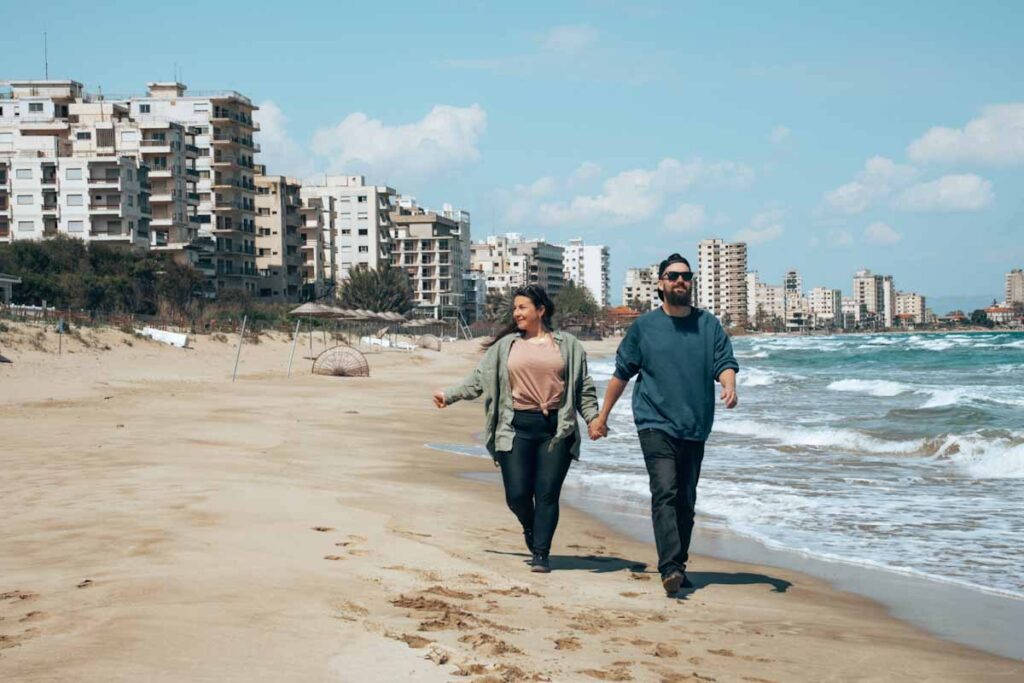
When visiting Varosha, you can’t go everywhere. There are marked paths where you can freely walk, but you can not cross behind the fences, ropes or signs. Most streets are closed. You can walk or bike around what once was a city centre, and part of the beach is also accessible. From time to time, you see soldiers peaking out the windows of abandoned houses or smoking cigarettes on balconies. They are watching you nonstop. The city sits at the best beach we have seen in the whole of Cyprus. What a shame. Varosha was not accessible until recently when it was newly open for visitors after the UN negotiated with Turkey in 2020.
Going to Cyprus? Read how to travel Off the beaten path in Cyprus here.
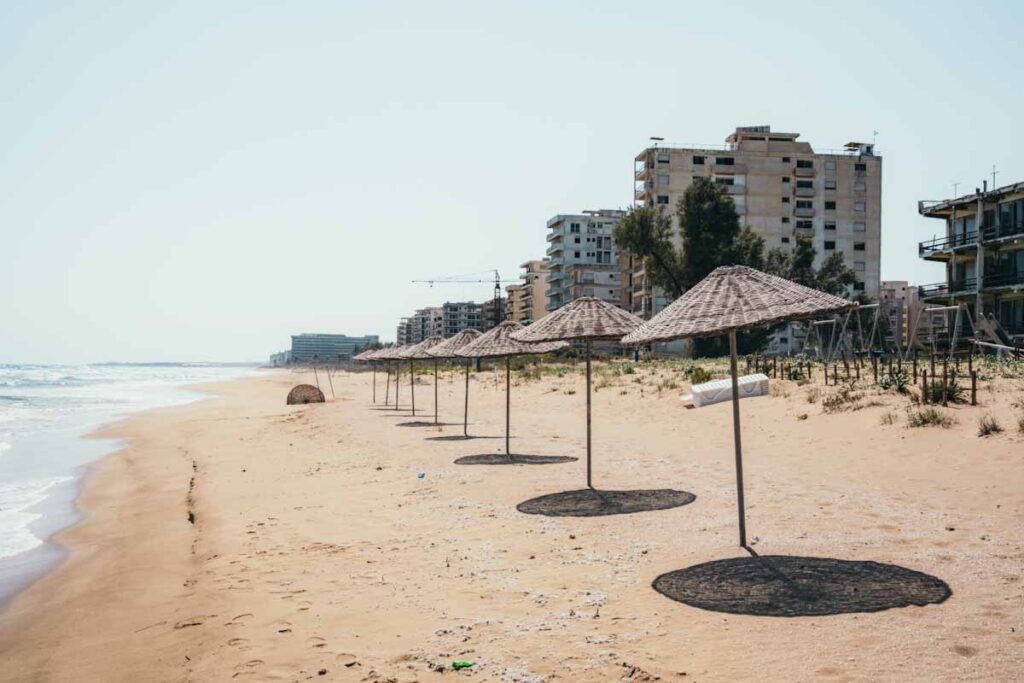
Know before you go
Can you drive a car into varosha.
Short answer: No. Cars are not allowed inside Varosha, except for cars from military personnel. You can arrive by car at the entrance of Varosha, where there are multiple car parks where you can leave your car. Then, you need to go through the security check, and you are on your own from there. You can either explore on foot or, as we explained below, you can rent a bicycle.
How much does it cost to visit Varosha?
Visiting Varosha is free.
Do i need a passport?
Yes, when we visited, security checked our passports at the entrance.
Can i move freely in Varosha?
You can move freely in designated areas. Only a small part of Varosha is open to the public, and you can easily see where you can and can not enter because the path is marked with ropes and signs.
can i buy there food and water?
A small cafe on the Maraş beach sells snacks, coffee and water. We also saw a food and ice cream truck, but it was closed when we visited.
Can i photograph everything?
Yes, you can take photographs everywhere in the public space in Varosha. However, it is still a military base, so avoid taking photos of areas with soldiers and military buildings that are clearly marked.
How much time do I need for Varosha?
At least 2 hours for visiting Varosha is great. We spent 3 hours, as we chilled on the beach and didn’t rush.
Are there toilets?
Yes. There are toilets beside the cafe in Maraş beach.
Can I swim on the beach?
Technically, yes, you can swim on Maraş beach. However, we have a feeling people don’t do it often. You can also stay in the Arkin Palm Beach Hotel , the only hotel in Varosha, and they have a private beach.
What are the opening hours of Varosha?
Varosha is open daily from 9am to 7:30pm.
Can I stay in Varosha overnight?
You can stay in the Arkin Palm Beach Hotel, the only hotel inside the Varosha, with private beach access. What an experience to stay overnight in the ghost town. Check the prices here.
Can I enter the abandoned buildings?
No. It is forbidden because of the safety. It can collapse anytime.
Do I need a guide for Varosha?
You don’t need a guide to Varosha. You can visit everything independently. If you are interested in a guided tour, check our recommendations here.
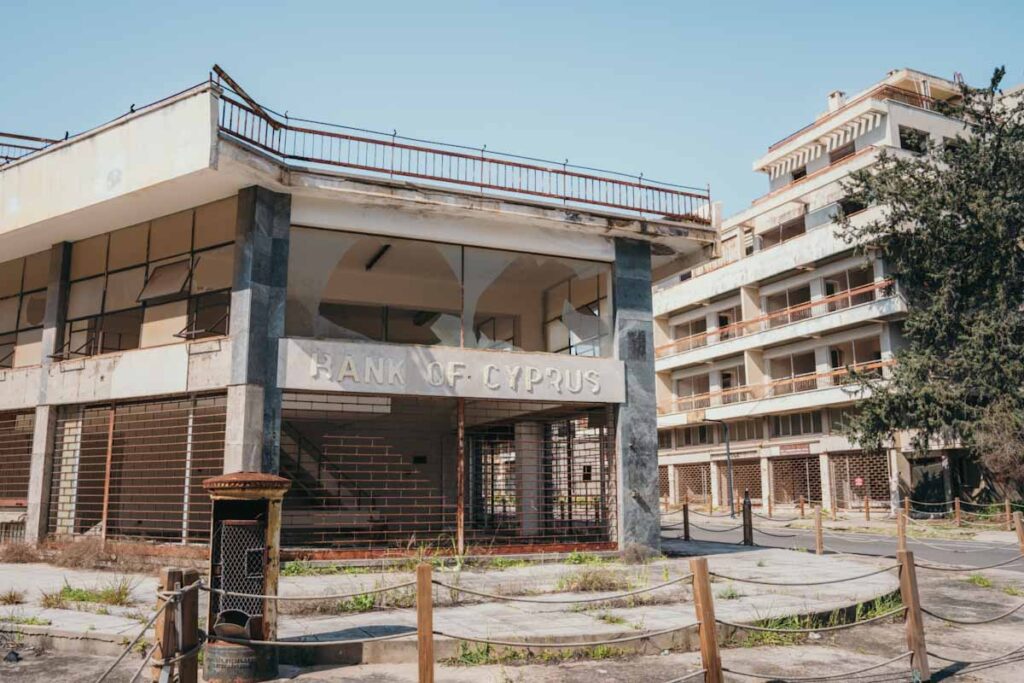
HOW TO GET TO VAROSHA
Varosha is 4 km from the centre of Famagusta in the Turkish Republic of Northern Cyprus (TRNC). Most travellers arrive in Cyprus and cross into TRNC using one of the many checkpoints described below. We flew into Larnaca, took a bus to Nicosia and crossed the border on foot into Lefkosa. Then, we rented a car and explored TRNC, including Varosha. You can fly to Larnaca with low-cost Airline WizzAir from many locations for as little as €50.
There is Ercan International Airport, which currently connects TRNC with multiple cities in Turkey. If you come through this route, it has the advantage that you can rent a car already at the airport and start your road trip. You can find great cars for around $30 per day on Discover Cars .
Check the cheapest flights to Larnaca here.

Checkpoint in Nicosia/Lefkosa
We crossed the checkpoint from Nicosia (Cyprus) to Lefkosa (TRNC), Europe’s last divided capital. We explored the TRNC by rented car from Lefkosa, so once we reached Famagusta, it was an easy drive to the entrance of the sealed-off city of Varosha.
There are multiple car parks near the entrance where you can leave your car. Then, walk to the entrance, where the military personnel checked your bag, passport and they wanted to see our camera. After a few minutes, we successfully made it inside.
Checkpoint in Famagusta
The most popular crossing if you start in Larnaca is a direct route between Larnaca and Famagusta. All the checkpoints have a big military presence and check all visitors coming through.

Crossing between South and North cyprus
- Visa: Citizens of the EU don’t need any visa to cross between the South and the North. If your passport is from somewhere other than the EU, you need to check if you need a Visa.
- Passport: TRNC and Cyprus both have their own rules and document checks. Ensure you know in advance if you need a visa and that your passport is valid.
- Rental car: To avoid hassle, it is better to rent the cars separately. We rented a car for TRNC in Lefkosa after we crossed the border on foot. And for Cyprus, we rented a car in Larnaca. If you want to cross the border to TRNC with a car from the South (or the opposite), you need to make sure you have all documentation and insurance ready and confirmation from the rental company if they allow you.
Read more: How to travel to the Turkish Republic of Northern Cyprus .
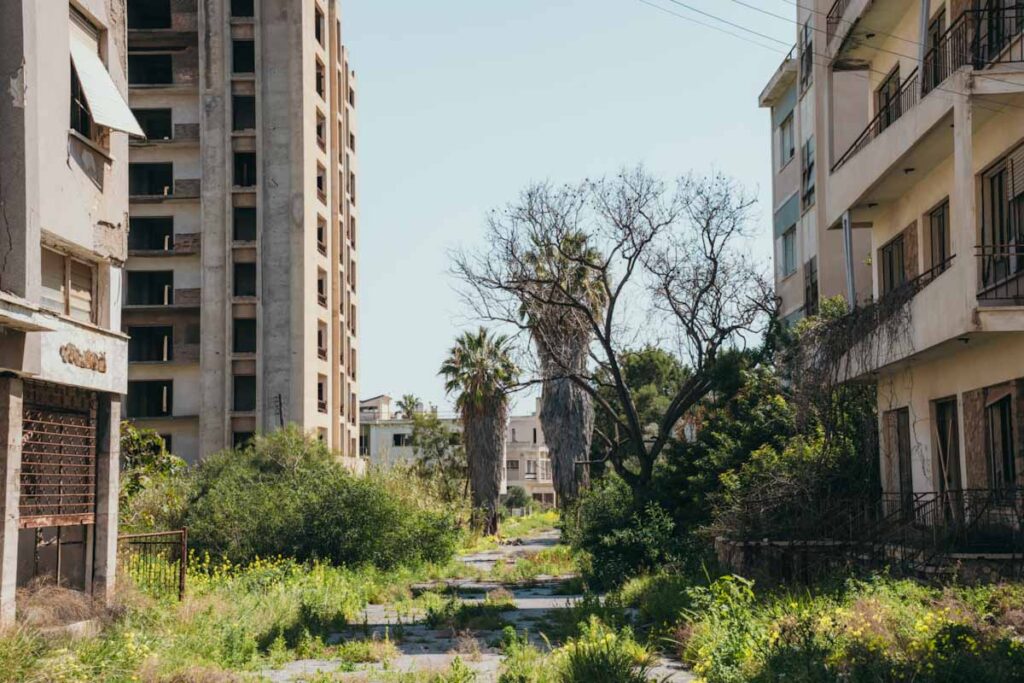
EXPLORE VAROSHA ON BICYCLE
The best way to explore Varosha is on a bicycle that can be rented at the entrance for 15 TL (price in 2022) for 2 hours. It gives you independence and energy to explore all streets in Varosha that are accessible. Even though most streets are inaccessible, the part that is open to the public is still quite big, so exploring by bicycle makes sense.
Ride a bike to the Maraş Plajı, the beach that is one of the most beautiful in Cyprus. Surrounded by abandoned resorts, sitting on this beach felt like being in an apocalypse movie. Occasionally, we noticed soldiers peaking out the windows of the abandoned resorts, smoking cigarettes and watching visitors.
It took us roughly 3 hours to explore Varosha , including a break on the beach, where we sat down and relaxed. We rented a bicycle for 2 hours but returned it after 3 hours, so we just paid the extra two hours after we returned the bike late.
Tip: Come early in the morning, around 9am, to avoid crowds. There are no huge crowds, but it is worth it to be early to enjoy the abandoned atmosphere for yourself before other visitors and bus tours arrive.
TRAVEL INSURANCE FOR VAROSHA For travelling in the Turkish Republic of Northern Cyprus and Cyprus, we recommend IATI Travel insurance , which fully covers travelling in TRNC and Cyprus. You can choose any of their packages and, as our reader, get an exclusive 5% discount. Get your 5% discount for travel insurance with IATI here.

EXPLORE VAROSHA WITH KNOWLEDGEABLE GUIDE
You can visit Varosha on a tour straight from Famagusta. Or also on a tour from Cyprus, in case you don’t stay in a TRNC. If you’re short on time or want to come for a quick, organised trip with a knowledgeable guide, the following tours are the best bet.
IS IT SAFE TO VISIT VAROSHA
Even though there is a huge military presence in TRNC, especially around the Green Line, visiting Varosha and the whole TRNC is a safe experience. Watch the recent situation in the area, which was very safe and calm in recent years. Don’t enter the buildings that can collapse, which is indicated by many signs in Varosha.
Interested in other quirky locations? Explore the ship cemetery in Uzbekistan.
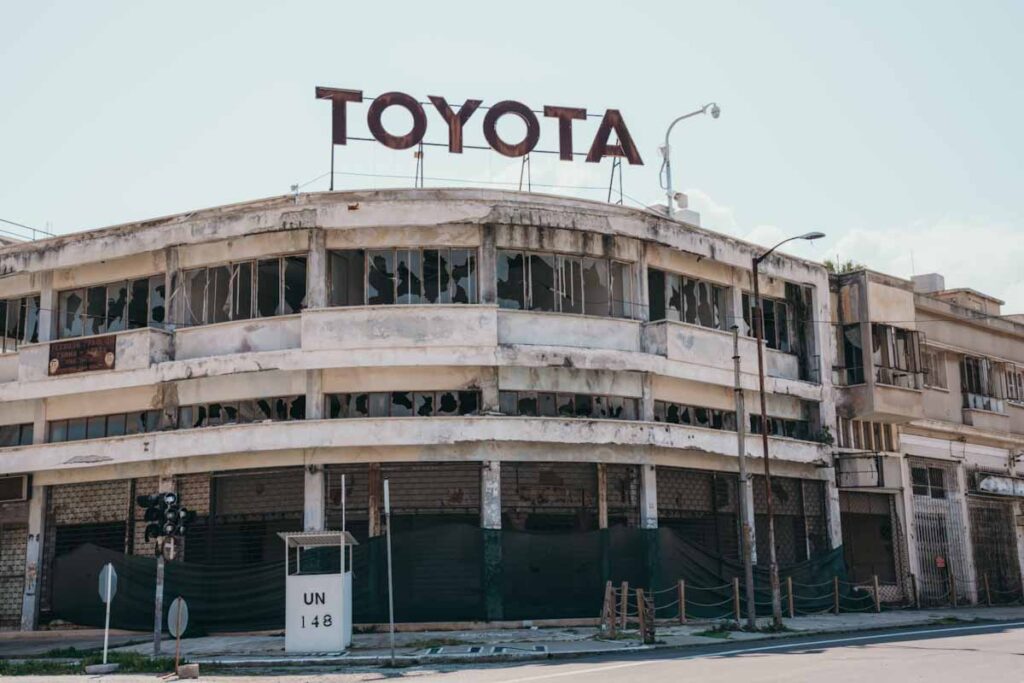
WHERE TO STAY WHEN VISITING VAROSHA
Mimoza Beach Hotel I Since we had a car, we decided to stay a bit away from the Famagusta centre and enjoyed off-season prices in the Mimosa Beach Hotel. The quality of the hotel was amazing; breakfast was included, the room was clean with a beautiful view over the ocean, and since we were there in March, it was very quiet. We paid 29€ per night for 2 people. And it is only 15 km from Varosha.
Stay in Famagusta
Budget I Mystery Garden Guest House – beautifully decorated traditional house in Famagusta centre is very popular for travellers visiting Famagusta and Varosha. Breakfast is included, the rooms are comfortable, and wifi works well. Travellers enjoy the beautiful garden and central location.
Mid-Range I La Regina Veneziana – Modern and stylish accommodation in the centre of Famagusta. Breakfast included. This stone house has a vibe, and you can relax after a full day of exploring the ghost town.
Stay in Varosha
Mid-Range I Arkin Palm Beach Hotel – only hotel where you can stay in Varosha. Spend a night inside the ghost town and enjoy their private beach.
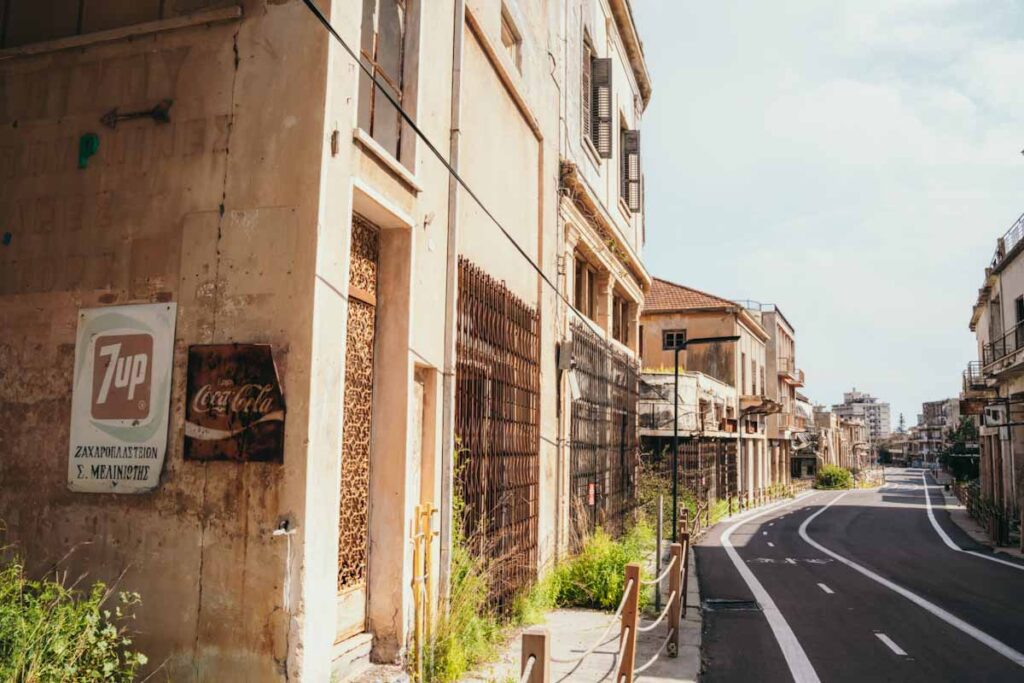
More from the Middle East
Comprehensive travel guide to Palestine & 11 days itinerary
How to visit Jerusalem in 24 hours: Safety, Tips, Itinerary
Visit & Stay in refugee camps in the West Bank.
How to travel to Lebanon & Ultimate 11 days itinerary
The best things to do in Beirut, Lebanon
Is it safe to travel to Lebanon? Our experience
How to travel to Syria & Is it safe to visit?
It’s time to plan your trip!
Find our travel resources below that help you plan your next trip. Good luck and safe travels.
Book your flight
Skyscanner is our favourite tool for searching for the cheapest flights and flight combinations. Multi-city or Explore Everywhere helps us to find real bargains.
The best platform to rent a car and compare the prices for your next road trip anywhere in the world is Discovercars.com . The booking process is hassle-free.
Find your acommodation
On Booking.com we always find the best deals for accommodation. Another great option for cheap accommodation is Hostelworld .
Travel insurance
We always recommend IATI Travel Insurance which offers excellent plans. As a reader of Broken Navigation, get an exclusive 5% discount. For Europeans Truetraveller offers perfect travel insurance for the best price.
Explore more with Tours
Some places are better off explored with a knowledgeable guide. Or, if you simply want to save time and hassle, we recommend GetYourGuide . Another great option that also has an amazing range of activities is Viator .
protect yourself online by VPN
We always use NordVPN everywhere we travel for safe internet browsing and access to specific sites that might be blocked.
Disclosure: We recommend only companies we personally use. If you book services through any of the affiliate links in our posts, it earns us a small commission at no extra cost to you.
Travelling for years now, she found the passion in unique and off the beaten path places. Romana is a food lover, but it doesn’t stop her from hiking the mountains for several days. By sharing her experiences, she wants to help you experience the same.
You may also like

How to travel to Moynaq and the Aral Sea, Uzbekistan in 2024
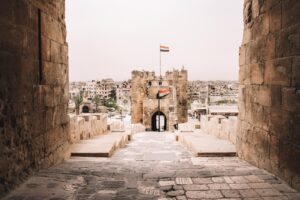
How to travel to Syria in 2024 & Is it Safe to Visit?

Taba Border Crossing from Dahab (Egypt) to Eilat (Israel) with Troubled Stamps in Passport
- Egypt , Israel

Dhiffushi Island: Travel Maldives on Budget, $39 per Day!
Leave a reply cancel reply.
Your email address will not be published. Required fields are marked *
Name *
Email *
Add Comment *
Email me when someone replies to my comment
Subscribe to newsletter
Post Comment
“There are no airports in TRNC”??? Yes, there is? Ercan Airport, daily flights
Hello Johnny, this must have slipped from our info. Thank you for catching that! It’s already corrected in our post.
Subscribe to our newsletter
Get access to exclusive content and stay up to date with the latest travel tips and news.
You can now tour a controversial ghost town in Cyprus that was abandoned in the 1970s — take a look inside
- After Turkey took control of northern Cyprus in the 1970s, the resort town Varosha was left empty.
- Residents and tourists planned to return, but the resort was fenced off and remained so for decades.
- In 2020, the town and surrounding beach reopened but soon became a point of controversy.
Varosha is a former resort town located in the city of Famagusta, Cyprus.
Before the division of Cyprus in 1974, Varosha was a booming resort town with sky-scraping hotels, glamorous shopping districts, and sandy beaches frequently called the best in Cyprus.
The rich and famous claimed Verosha as the most beautiful spot on the island.
According to the BBC , celebrities including Richard Burton, Elizabeth Taylor, and Brigitte Bardot visited the island in its heyday.
"Anyone who comes from Varosha has a romanticized notion of it," Vasia Markides, an American Greek-Cypriot whose mother grew up there, told the BBC in 2014. "They talk about it being the hub of art and intellectual activity. They describe it as the French Riviera of Cyprus."
At its height, the resort town of Varosha was home to 39,000 residents and thousands more visited each year as tourists.
Varosha also attracted around 700,000 annual visitors and tourists .
But after 1974, everyone but the Turkish military was forbidden from entering, and today, buildings in the once-booming resort town are crumbling and abandoned.
According to the BBC , after years of violence, Turkey invaded Cyprus in 1974 following a Greek-government-backed coup and gained control of the northern third section of the island, which included the district of Varosha.
Tens of thousands of Greek Cypriots quickly left the area, fearing violence but intending to return once tensions settled down.
Former residents have recalled their panic while fleeing their homes as troops invaded.
Some left their wedding presents in their attics, while others said they still had pots cooking on the stove when they evacuated.
Following the invasion, the resort was fenced and blocked off by the Turkish military. It was abandoned for decades.
What was once a glamorous resort became a barren wasteland dotted with falling fences and barricades.
Varosha remained part of the self-proclaimed Turkish Republic of Northern Cyprus, or TRNC, until a United Nations resolution in 1984.
The decision placed Varosha under the control of the United Nations and forbade anyone other than those who were forced out in the 1970s from resettling there, according to BBC .
While the city of Famagusta is home to thousands of residents, who are mostly Turkish, the Varosha sector was blocked off until recently.
Decaying buildings and rubble line the streets of the abandoned district.
Signs labeled Varosha a "forbidden zone."
Tourists were previously banned from entering or taking photos inside the fenced-off areas, but some managed to slip through over the years and documented what was left behind.
After the town reopened in 2020, Turkish Cypriots were allowed through the fences to explore what remained. Now, anyone can visit with a valid passport .
Before it reopened, buildings could be seen slowly collapsing, abandoned cars were rusting over, and the streets lay empty.
Many areas of the Varosha district are still blocked off for most people, according to the BBC .
After travel restrictions were eased in 2003, former residents were allowed to return and peer into the forgotten resort through fences and barbed wire.
However, those who ventured back to the island found the once-booming area a crumbling ghost town and have not been permitted to permanently inhabit the town.
Much of the resort remained largely how its former residents and visitors left it.
Tables were still set for meals and designer clothes could be found hanging inside now-abandoned shops.
Cypriots returning to Varosha described it as "some sort of post-apocalyptic nightmare."
"The picture that I had in my mind was of a kind of paradise," one Cypriot who returned to look across the fence at her family's former home told the BBC .
"You're seeing nature take over. Prickly pear bushes have overrun the entire six square kilometers. There are trees that have sprouted through living rooms. It's a ghost town," she said .
The reopening of Varosha, also known by its Turkish name Maraş, became a subject of controversy between the Greek Cypriot and the Turkish Cypriot communities.
According to a report by CNN in 2020, Ersin Tatar, prime minister of the self-declared Turkish Republic of Northern Cyprus, planned to start the reopening and potential rebuilding process in 2020.
"It's all ready in my opinion," Tatar said in August 2020, according to Turkish state broadcaster TRT. "The tide has changed and a new page has been turned ... Maraş is within the territory of the TRNC. Nobody can take it from us. We are continuing on our successful path."
Turkish President Recep Tayyip Erdogan also said he wanted to reopen the resort town, but the move received backlash from Greek Cypriots.
When the beach reopened and the fences surrounding Varosha were removed, the government only allowed Turkish and TRNC citizens to visit at first.
Ahead of Varosha's reopening in 2020, the European Union's foreign policy chief warned the reopening would "cause greater tensions" between Turkish and Greek Cypriots, who disagree on who rightfully should inhabit and profit off the northern section of the island.
US officials have also spoken out against the reopening of Varosha. According to The Guardian , Secretary of State Antony Blinken said in 2021 that the government opposed any attempt to reopen Varosha to tourists and locals alike.
In a statement, Blinken called the Turkish Cypriot actions in Varosha "provocative, unacceptable, and incompatible with their past commitments to engage constructively in settlement talks."
"We urge Turkish Cypriots and Turkey to reverse their decision announced today and all steps taken since October 2020," he continued.
Tourists have returned to the beaches, but behind them sit decaying hotels.
The buildings are unsafe to go inside, but tourists have once again returned to the town's sandy beaches.
Today, visitors from across the world can swim in Varosha's waters and take guided tours alongside the crumbling buildings.
According to the Cyprus Mail , visitors can tour Varosha between the hours of 8 a.m. and 8 p.m.
While visitors are not allowed to actually enter the blocked-off and crumbling buildings due to safety concerns, tour groups are permitted to walk alongside them, snap photos, and learn about the resort town's complicated history.
- Main content
- Search Please fill out this field.
- Manage Your Subscription
- Give a Gift Subscription
- Sweepstakes
This 'Forbidden' Cyprus Ghost Town Has Been Frozen in the 1970s — and Now It Hopes to Attract Tourists Again
Forbidden to the public ever since the 1974 division of the Mediterranean island, the Varosha resort in Famagusta hopes to attract visitors like in its heyday.
:max_bytes(150000):strip_icc():format(webp)/rachel-chang-36aff37f3d95496b8a40a59781ef89c2.jpg)
On the east coast of the Mediterranean island nation of Cyprus is a ghost town trapped in time. There’s a car dealership filled with cars from 1974 and shops with '70s fashion in the windows — at least that’s what the few who have ventured into the restricted zone of Varosha have said .
After Cyprus was divided in 1974 into the Turkish-Cypriot north and Greek-Cypriot south, the residents of the former resort district of Varosha in the city of Famagusta were forced to flee, and the area became part of the UN Buffer Zone known as the Green Line . A 1984 security resolution from the UN prohibited resettlement, so the only people who have legally been inside the now-fenced off area are the Turkish military.
Now, 46 years later, the prime minister of the Turkish Republic of Northern Cyprus, or TRNC, Ersin Tatar hopes to reopen the area to the public.
In its prime, Varosha was home to 25,000 residents and attracted visitors from around the globe in the early 1970s, drawing big names like Elizabeth Taylor, Richard Burton, and Brigitte Bardot to its 12,000 hotel rooms.
“At this point we are close to the point of starting the reopening process,” Tatar told the Turkish state broadcaster TRT, according to CNN . “It's all ready in my opinion... The tide has changed and a new page has been turned.”
While no timeline has been released, Tatar says the upcoming elections may delay plans, but he’s committed to bringing the once popular tourist attraction, which is known as Maraş in Turkish, back to its former reputation as a luxury getaway. “Maraş is within the territory of the TRNC,” he added. “ Nobody can take it from us. We are continuing on our successful path.”
The seaside resort’s fate was set after the Turkish military forces fought back after a Greek government coup on July 15, 1974 . The area is now recognized by Turkey as belonging to the TRNC, according to the Daily Mail .
Varosha isn’t the only abandoned town after Turkish and Greek tensions. In Turkey, the community of Kayakoy also sits in ruins after a 1923 population exchange between the Greek Muslims and Turkish Christians.

A Visit to Varosha: The Abandoned Ghost City of Cyprus
Standing with my feet in the warm sands of the Palm Beach hotel in Famagusta, an eeriness washes over me. The beach is awash in tourists sunning under crisp linen parasols, seemingly unaware of the spectre looming over them. The vacant, crumbling windows of hundreds of the most exclusive hotels and villas in Cyprus shadow the popular, pristine beach, like eyes watching your every movement. This is the once illustrious city of Varosha , cordoned off under Turkish military rule and left to decay slowly, visibly behind huge barbed wire fences which fringe the sand.
Vagabondish is reader-supported. When you buy through links on our site, we may earn a small affiliate commission. Read our disclosure .
Ostensibly, Famagusta may seem like an unlikely place for a ghost town with its pristine beaches and popular tourist centres. But the beautiful East Cypriot coast has been torn apart by war, the city of Varosha a surreal relic of the conflict, frozen in time. Life disconcertingly continues around the forbidden zone, I watch swim-suited men and women play casually in the surf, watched over by the burnt-out shells of luxury hotels and high-rise apartment blocks.
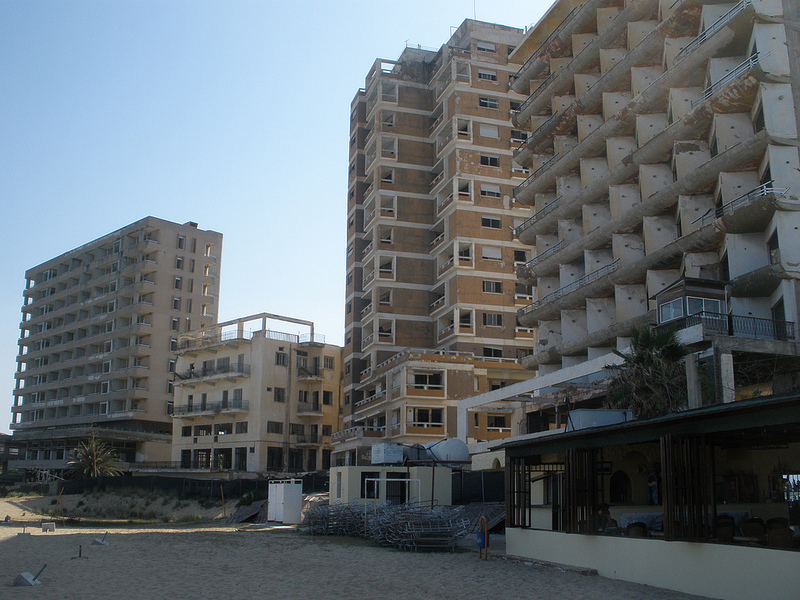
A Fall from Grace
In the early 1970’s, the azure coastline and beautiful beaches of Varosha, Famagusta , were a sun-soaked playground for the rich and the famous. Providing some of the most lavish hotels and restaurants in Cyprus, the city was one of the most popular tourist destinations in the world. Varosha’s cornucopia of sky-rise hotels and exotic beach bars played host to the crème de la crème of Hollywood, counting Elizabeth Taylor, Richard Burton and Brigitte Bardot amongst its guests.
Light-bulbs still flicker in shop windows displaying dusty seventies fashions and car showrooms sit vacant, full of now-vintage 1974 models, sitting on flat-tyres, rusting.
On July 20th, 1974 the glamorous lifestyle of Varosha was brought to a screeching halt by the Turkish invasion of Cyprus. As the Turkish and Greek Cypriot armies advanced to meet in combat on Famagusta streets, the citizens of Varosha fled, leaving their possessions behind, fearing a massacre. For the last 40 years, the city has remained vacant, fenced-off and under the control of the Turkish military.
Varosha today is a no-man’s-land, fallen far from its golden perch amongst the Hollywood jet-set. Those who have risked their lives to sneak a rare glimpse behind the barbed wire fencing describe the city as surreal and unnatural. Light-bulbs still flicker in shop windows displaying dusty seventies fashions and car showrooms sit vacant, full of now-vintage 1974 models, sitting on flat-tyres, rusting.
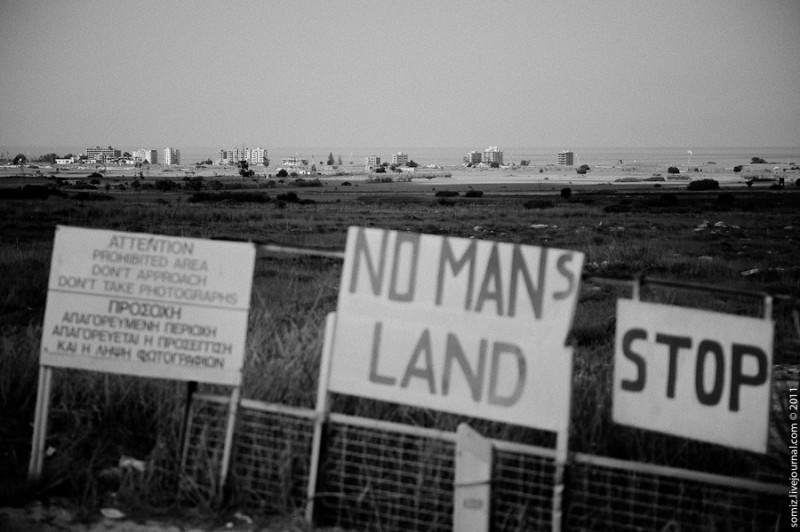
The husk of the once illustrious city is now touted as a tourist spot on street corners. You cannot walk the main strip without someone claiming they can provide the closest access to the forbidden zone. These tours may well involve taking your life in your hands as heavily armed guards line the wired-off perimeter, authorised to shoot anyone who wanders too close.
The city itself dominates the skyline of the Turkish-Cypriot town of Deve Lamani. Several times I got lost looking for a specific bar or restaurant only to come up suddenly against the huge fence running the perimeter of the once-illustrious town and find myself staring into an abandoned villa or hotel reception, dust piling up on abandoned furniture, the windows blown in, shutters hanging off.
For the last forty years, this ghost town has fallen into disrepair whilst fruitless negotiations have moved back and forth between the two sides. The Turkish Cypriot presidential spokesman Osman Ertug recently described Varosha as a playing card in negotiations with the Greeks. As a result of this inertia, the European Commission is said to be driving negotiations between the two sides to attempt to broker a deal for the restoration of the city.
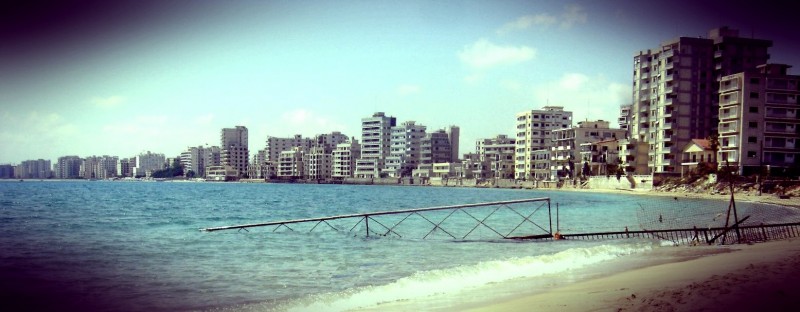
Restoring the Past
Many local Turkish residents believe Cyprus’ current economic breakdown will become a vital bargaining chip in the restoration of Varosha. The Cypriot government are said to be considering the possibility of offering Turkey a key role in regional gas export, giving Turkey a portion of profits from Cypriot and Israeli gas supply to Egypt.
An agreement of this nature could be very positive for Cyprus’ future, securing the return of Varosha and other Greek-Cypriot territories and making vital headway for peace talks. Cypriots from both sides mourn the decline of Varosha and the city is seen as lasting symbol of the conflict, one which even nearby Turkish residents have admitted they find ”˜ sad and very disturbing .’
The return of Varosha to its rightful owners is being touted by the Greek Cypriot leader Dimitris Christofias as a ”˜ litmus test ’ to indicate Turkey’s goodwill for the future to resolve issues between the two sides and open discussions for reunification.
Whatever the outcome, the glorious legacy of Varosha is in tatters, luxury hotels now nothing but burnt-out shells, all power and water systems eroded and antiquated. Urban planners have estimated the cost of reinstating Varosha to its previous splendour at around £8 billion, and requiring around ten years. The prospect of reinstating the legendary ”˜ ghost town ’ must seem an ominous one for failing Cypriot banks.
Exploring the No Man’s Land of Present-Day Varosa
Heading down the shoreline at Palm Beach, I hear a sharp shout in Turkish and a clunk as the safety is clicked off an automatic rifle. I lower my camera phone slowly and return it to my pocket. Turning around, I see the Turkish guard behind shrug and go back to his conversation with a local restaurant owner. Photography is strictly forbidden at the barbed-wire boundary, but I wanted to try my luck. It’s impossible to describe the ghostliness of the vacant buildings, once so desirable, now reclaimed by no one but nature, with hedgerows and vines tearing through brickwork and cement.
Standing on the beach, arm outstretched through the fence, I can touch the peeling paint of the high-rise hotel behind, once a luxury destination, now a derelict husk. If the inertia of Greek and Turkish leaders continues, this may well be the closest anyone gets to the city for another four decades.
In the meantime, the city continues to crumble, waiting for an agreeable solution to be reached by the rival Cypriot sides. Until this day comes, Varosha will remain a city in limbo, caught between the ages, restaurants and bars still waiting for the glamorous customers of 1974 who never returned.
Thank you for sharing this story. I got chills reading it. I visited Nicosia in 1986 when my brother was serving in the Greek Army. Still hard to believe unification has not happened!
Thanks for reading. It’s an incredibly eerie place – such a shame to see all of those beautiful buildings crumbling because of the inactivity of political leaders! Especially when people’s livelihoods have been destroyed in the process.
It sure would be a fascinating experience to walk those abandoned streets. I bet they could make a great deal of money if they would open it for tours. If people are willing to take tours of chernobyl, they certainly would want to see this place.
I was Stationed AT RAF Ayios Nikolaos in 1963-1965, the Turkish government threatened to invade then due to abolishment of the constitution, our families were on a 2 hour warning in case they had to depart quickly. I remember the market place the walled city the harbour the NAFFI store, the corner bar close to where I had an apartment, the Island seemed so quite then, and the folk where very friendly towards British forces. the beach was outstanding, hardly any hotels or buildings, I would love to visit Verosha/ Famagusta, again, in a way I feel sad for all the people I knew then, both Turks and Greeks. Maybe some day they will get their finger out and restore this beautiful part. Wishful thinking, maybe.
Do the Turkish army live in the ghost town as you can see some people moving around on g maps and cars driving in and out near main beech
Hello! Interesting post. Where did you take those photos with the No-man’s-land and stop boards? Looks like you had to walk a huge distance. Thank you!
Leave a Reply Cancel reply
Your email address will not be published. Required fields are marked *
Save my name, email, and website in this browser for the next time I comment.
Notify me of followup comments via e-mail. You can also subscribe without commenting.
- Skip to primary navigation
- Skip to main content
- Skip to primary sidebar
- Skip to footer
Hazel's Travels
Travel inspiration for Europe, UK & USA
Famagusta Border Crossing: How to Visit the Ghost Town of Varosha in 2024
Last Updated on January 3, 2024 by Hazel M
Are you looking for information on how to cross the Famagusta border crossing ahead of your trip to Northern Cyprus? Or planning a visit to the ghost town of Varosha? This guide will tell you everything you need to know before you travel, including considerations for Cyprus border crossings and how to get into the ghost town itself.
I crossed the border into Northern Cyprus in October 2022 , and I visited Salamis, Famagusta and Varosha. This guide will help you to understand all of the requirements of the Famagusta border crossing and the ghost town of Varosha.
This article has been updated to keep it relevant for 2024, but the photographs are all from 2022.
I may earn a commission at no extra cost to you if you make a purchase through my affiliate links.
In a hurry? Here are some quick links:
- You can book a tour to take care of the border crossing for you.
- Book the best 5 star luxury hotel in Cyprus here .
- Here are the best deals on all Cyprus hotels .
- It gets very hot in Cyprus. You need decent sunscreen and a packable sun hat .
- A Turkish phrase book will come in handy.
- Book your Cyprus rental car here .
- If you want to cross the border, read this guide first .
This article is about crossing the border into North Cyprus at the Eastern Base crossing near Famagusta. There are other crossings you can use , and these are detailed below. This article also covers the ghost town of Varosha and general traveller information about Northern Cyprus.
Introduction to Famagusta
Famagusta is an historic city located in the eastern part of Cyprus . It is an important city-state and was once the seat of the powerful Lusignan dynasty, which controlled much of the island from 1192–1489.
The old town of Famagusta houses some impressive fortifications and fascinating medieval architecture, plus it also boasts one of Europe’s most beautiful natural harbours.
Famagusta Border Crossing
The city of Famagusta is located in Turkish-occupied Northern Cyprus, which means that if you’re coming from South Cyprus , you’ll need to cross the Turkish border. There is a high military presence here, and you’ll need to know what to expect from both sides.
Below I have listed the most commonly searched questions on Google in 2024, relating to the Famagusta border crossing and the Varosha ghost town of Northern Cyprus.
I have split these questions into five categories:
- FAQs about Famagusta’s history
- FAQs about the Famagusta border crossing (including map)
- FAQs about the ghost town of Varosha
- FAQs about what Famagusta is like today
- FAQs about Famagusta general tourist information
1. FAQs about Famagusta’s history
What happened at famagusta.
In 1974, Turkish troops invaded and occupied Northern Cyprus. This resulted in the displacement of tens of thousands of Greek Cypriots, who were forced to flee their homes. Hundreds of people were killed, including tourists. The resort town of Varosha became a ghost town overnight. The buildings were left abandoned and fell into disrepair. In recent years, the UN has negotiated with Turkey, and the town is now open to visitors.
How important did Famagusta used to be?
Famagusta is a city with a long and rich history. The city was once an important trading hub, and you can still see evidence of this in the city’s architecture. It has the deepest harbour in Cyprus and used to be the main trading route with the merchants of the Silk Road. However, because of its location in Turkish-occupied Northern Cyprus, Famagusta has been somewhat cut off from the rest of the world. This isolation has led to a decline in tourism, which has in turn led to a decline in the city’s infrastructure.
What is Famagusta like today?
I found the main part of the city to be very quiet. It does feel different to the cities in South Cyprus, because it is Turkish, but I did not feel any tension when I was walking around. It is important to remember it is not the people who went to war; it was their governments. The Turkish people are just living and working here in a normal manner.
I took these pictures below in the city of Famagusta in October 2022. This is not the ghost town (the ghost town is Varosha – more on that below).
2. FAQs about the Famagusta Border Crossing
Where is the famagusta border crossing.
This political map shows where the border runs across Northern Cyprus, and sovereign base areas. The purple area is the UN buffer zone, and this is the area you must cross if you want to visit Famagusta from south of the border. Famugusta is on the right, just above the purple border.
Do you need a passport for the Famagusta border crossing?
Yes, you’ll need a valid passport in order to cross the border into Northern Cyprus. The military officers will check your passport upon entry, so make sure it’s in good condition and that you have all the necessary visas.
Do you need a visa for the Famagusta border crossing?
Citizens of the European Union do not need a visa to enter Northern Cyprus. For nationalities outside of the EU, you will need to check with the Turkish consulate in your home country for visa requirements and how to visit Famagusta.
Where is the Famagusta border crossing point?
The crossing I used was the Akyar crossing (also called Strovilia or Azios Nikolaos) in the British Eastern Sovereign Base Area in Famagusta. This is on the Larnaca-Famagusta road, and can be used by pedestrians, vehicles and cyclists.
What other border crossing points are there?
Below are some of the other border crossing points. They are a little confusing, as they all have several names (Turkish and Greek Cypriot names). You can walk or cycle over all of them, but driving is restricted to diplomatic vehicles only at Ledra Street.
- Metehan (also called Agios Dometios or Kermiya) in the west of Nicosia.
- Ledra Palace/Ledra Street in central Nicosia (only diplomatic vehicles allowed).
- Dhekelia (also known as Beyarmudu, Pergamos or Pile).
- Yesilirmak (also known as Limnitis) near Guzelyurt (Morpho).
Can I drive a South Cyprus hire car over the Famagusta border crossing?
Some South Cyprus hire car companies will allow their cars to be taken over the border for an extra insurance fee. You will need to discuss this with the car company (I recommend Discover Cars ). Some companies do not allow cars over the border so you will need to check first. You’ll need to have both Turkish lira and euros with you in order to pay for things like fuel and tolls.
You can also take a bus or drive your own car (make sure to check your car insurance first).
Can I drive a North Cyprus hire car over the Famagusta border ?
It is not advised to cross the border in a North Cyprus hire car at this time. Most North Cyprus car companies will not allow their cars to be taken to the south. It is common for North Cyprus car companies to be stopped at the crossing by the military, even when the company allows it, so I wouldn’t risk it.
Are the Cyprus border crossings well-signed?
The south-to-north border crossings in Cyprus are well-signed, but the north-to-south boundaries are not well-signed at all. Additionally the signs in North Cyprus are in Turkish, with different names for the towns and cities, so it can get very confusing. You can pick up a Turkish map at most of the border crossings.

What do I have to do at the Famagusta border crossing into Northern Cyprus?
At the Famagusta border crossing, you’ll need to present your passport and fill out a customs declaration form. They stamp the form, and you keep the form together with your passport for your return journey. You’ll also need car insurance documents if you are driving (or purchase your insurance at the border).
Who controls the Famagusta border crossing at South Cyprus?
The Turkish government controls the Famagusta border crossing. It is a military checkpoint. There is also a presence from the United Nations Peacekeeping Force in Cyprus (UNFICYP) and the British Military as well.
Who controls the Famagusta border crossing at North Cyprus?
The border crossing back into South Cyprus is controlled by the Cyprus police and the British military. On the way back, your passport and VISA documentation will be checked by the Cyprus police and also the British military. They will also look to see what you have purchased and what you are bringing back to Cyprus with you.
What does the UN do at the border crossing?
The UN monitors the Famagusta border crossing to ensure that people are following the rules and regulations. There is a large UN camp near the border crossing, and you may see UN vehicles driving around the city.
Why are the British military at the Famagusta border crossing?
The British military has three base areas in Cyprus, from which it helps to maintain the peace and also leverage its relations across the rest of Europe.
According to the SBAA , the “Sovereign Base Areas (SBAs) of Akrotiri and Dhekelia, usually referred to as Western Sovereign Base Area (WSBA) and Eastern Sovereign Base Area (ESBA), are those parts of the island which remained under British jurisdiction on the creation of an independent Republic of Cyprus in 1960”.
What do the British do at the Famagusta border crossing?
The British military officers check passports when you are coming back over the North Cyprus border, and they also help to enforce the rules and regulations. I found them pleasant to deal with, and had no problems. However, do be aware that all of the military personnel carry big guns – this can be a little shocking if you do not often see guns in your home country.
Can I bring purchases back into South Cyprus from North Cyprus?
You can bring some purchases back into Cyprus from Famagusta. Cigarettes and liquor are restricted. I was advised by locals to remove the labels from clothing and actually wear it, rather than try to take it through in a carrier bag. I did not try this, so I cannot comment further.
What products can I bring with me from North Cyprus into South Cyprus?
Due to customs and excise regulations, there are limits on how much tobacco or spirits can be transported from the north to south across the border. The legal amount permitted per individual is outlined below for your reference.
- 0.5 Litre of Spirits
- Two Packets of cigarettes
- 1 bottle of wine
If you recently purchased or are currently in the process of finalising a property purchase, it’s important you do not bring any documents related to your real estate with you when travelling through the checkpoints.
Are the Cyprus border crossings open 24 hours per day?
All crossings are available 24/7, but if you are driving and you need car insurance for Northern Cyprus then you should go through the Agios Dometios (Metehan) crossing point, located in Nicosia (Lefkosa). This entryway offers round-the-clock car insurance services. Other borders only offer car insurance during office hours.
Are there any North Cyprus airports I can use, to avoid making the crossing?
Technically you are only allowed to enter and exit the Republic of Cyprus at the Larnaca and Paphos airports. You can also enter and exit at the seaports of Limassol, Larnaca, and Paphos. You will then need to cross the North Cyprus border.
The Republic of Cyprus does not consider entry at Ercan Airport in the north to be a ‘legal’ entrance into Cyprus, however some people do this at their own risk. Always check your government’s travel advisory page for further information.
3. FAQs about the ghost town of Varosha
Is famagusta still a ghost town.
Please note Famagusta is not ‘the ghost town’ you may have heard about. The ‘ghost town’ is the smaller resort-town of Varosha.
The ghost town of Varosha still remains untouched. It was once an upscale resort town with many 5 star hotels, but has been abandoned since the Turkish invasion in 1974. Nature has taken over the area, and it’s eerily beautiful in a sad sort of way.
Whilst Varosha is open to the public, getting there is not easy and it’s best to go with a guide.
Can you walk around the ghost town in Famagusta?
Yes, you can walk around the ghost town in Famagusta, this is the town of Varosha mentioned above. However, it is important to be aware of your surroundings and not to touch any of the buildings. The structures are dangerous and could collapse at any time. This area was opened to the public in 2010, and it is still considered to be a dangerous place. The buildings are derelict and there are a number of collapsed roofs.
Are there tours of the Varosha ghost town?
Yes there are tours of the ghost town, and these are the best ones available on Viator :
- Private Town of Varosha Ghost Town : half day tour which goes up close to the decaying buildings.
- Day trip to medieval Famagusta : day tour includes Varosha.
- Salamis and Varosha from Paphos : bus tour from Paphos, price includes Famagusta border crossing.
- Famagusta, Salamis and Varosha bus tour : full day tour with Famagusta border crossing included (I have been on this tour and can recommend it, but be aware it is a long day).
Is visiting Varosha emotional?
Yes, visiting Varosha can be emotional. The town is a reminder of the violence of the Turkish Invasion and the suffering of the people who were forced to flee their homes. It is also a reminder of how quickly things can change. Varosha was once a thriving tourist destination, and now it is a ghost town. If you go on a tour , your tour guide will likely be of Cypriot origin who will understandably feel strongly about the situation, as they would have been personally affected.
4. FAQs about what Famagusta is like today
Is famagusta open to the public.
Yes, Famagusta is open to the public. However, because of its location in Turkish-occupied Northern Cyprus , some areas of the city may be off-limits to tourists. You will need the necessary documentation to pass through the military checkpoints.
Is Famagusta Turkish or Greek?
Famagusta is Turkish. It is occupied by Turkish troops and the currency used is the Turkish lira. The previous Cypriot residents no longer live here because they were forced to flee to South Cyprus when the Turkish troops invaded in 1974.
What is the food like in Famagusta?
The food in Famagusta is a mix of Turkish and Cypriot cuisine. You can find a variety of traditional dishes, as well as more modern fare. I ate in a Turkish restaurant and I found it very pleasant. As a solo traveller with limited Turkish and Greek language skills, I was able to communicate without any problems and I found the people very pleasant. The locals recommended I try the Turkish chicken shish kebab (see below) and it was very good.
Is it safe in Famagusta?
You should always check government travel advice in your home country before you book your trip.
You will see military personnel carrying guns throughout Northern Cyprus, but they generally don’t bother tourists and there haven’t been any major incidents in recent years. However, it’s always a good idea to stay aware of your surroundings and keep your belongings safe. Also be aware of the buildings in Varosha which could be dangerous if you go too close.
For safety and peace of mind, you may like to consider the following safety recommendations (all products from Amazon):
- Use an anti-theft sling bag or an anti-theft backpack .
- Keep bank cards safe with an RFID blocking pouch or an RFID travel wallet .
- Use a portable door lock to lock your room from the inside.
- Try using an alarmed door stop for extra peace of mind.
- Use a compact travel safe (I have used this one and this one ).
- You can also get hidden travel safes , for example in the shape of a water bottle , coke can , hairbrush or even a holy bible .
- A waterproof and fireproof document pouch will protect your travel documents.
What is there to do in Famagusta?
There are a number of things to do in Famagusta. The city is home to a number of historical sites, as well as shops and restaurants. The ancient ruins of the city of Salamis are nearby. You can also visit the abandoned city of Varosha, which was once a thriving tourist destination before it was abandoned during the Turkish Invasion.
Is there a beach in Famagusta?
Yes, there is a beach in Famagusta. However, because of its location in Turkish-occupied Northern Cyprus, the beach may not be as well-maintained as other beaches in Cyprus . The derelict buildings remain empty on the promenade and there may be a lack of public facilities.
What is the water like at Famagusta beach?
The water at the Famagusta beach is clean and clear, and usually warm. However, because of its location in Turkish-occupied Northern Cyprus, the beach is not as well-maintained as other beaches in Cyprus , and there may be a lack of facilities.
If you are going to the beach, I recommend this beach towel which repels sand and dries almost instantly.
5. General FAQs & tourist information on Famagusta
What is the currency in famagusta.
The currency in Famagusta is the Turkish lira. However, because of its location in Turkish-occupied Northern Cyprus, euros are also accepted. Most of the shops and restaurants will accept euros as it is in their best interests; however some of the more traditional Turkish places may only accept Turkish lira.
What is the best time of year to visit Famagusta?
The best time to visit Famagusta is from April to October. The weather is warm and sunny during this time, making it ideal for exploring the city. I visited in October and it was quite warm, although there was also a storm with light rainfall. I recommend taking a packable rain jacket like this one .
What language is spoken in Famagusta?
The official language in Famagusta is Turkish. However, because of its location in Turkish-occupied Northern Cyprus, Greek is also spoken. I did also find some English spoken in the main restaurants and shops too. It is a good idea to take a translation app with you on your phone, or a Turkish phrase book , in case you need it.
Are there ATMS in Famagusta?
There are a few ATMs in Famagusta, but they are not always reliable. It is best to bring enough cash with you to last your entire trip. Remember the currency is Turkish Lira and Euros. I did not need any Turkish Lira, as everywhere I went accepted Euros, but it probably depends on what you want to buy.
How far is Famagusta from Nicosia?
Famagusta is 75 kilometres (47 miles) east of Nicosia, and easily accessible by car or public transport. It takes about 1.5 hours to get there. North Nicosia is under Turkish control, and the main street which links the two sides of Nicosia is called Ledra Street. Here you can see the famous Ledra Palace, on the UN buffer zone (or the ‘green line’). There is also a part of Agios Dometios which is under Turkish control too.
Are there any luxury hotel options near Famagusta?
Yes, there are several luxury hotels located near the city, including the five star Salamis Bay Conti Hotel Resort & SPA & Casino , Palm Beach Hotel .
Other 5 star hotels in Northern Cyprus include the Concorde Tower Hotel & Casino in North Nicosia and the Savoy Hotel Spa & Casino in Kyrenia. These hotels offer excellent facilities and amenities for your stay.
You can view all hotels in Famagusta on Booking.com , or use the interactive map below:
Is there public transportation available in Famagusta?
Cyprus does not have a train or underground system. However there is a bus network called OSEL (Omni-Stop Express Line) that runs through most parts of the city. This service operates between 6:00am and 11:30pm daily, allowing you to get around the city with ease. The fare is €1.50 for a single ticket, or €2.40 for a return journey. Click here for timetables .
Is Famagusta ok for beginner travellers?
Yes, Famagusta is ok for beginner travellers. However, it is important to be aware of your surroundings and not to touch any of the buildings at Varosha. The structures are dangerous and could collapse at any time. You also need to be aware of the military rules and do your research about how to visit Famagusta before your trip.
If you are nervous about the border crossings, I recommend using a local tour company who can sort the crossing conversations for you. This is especially important if you are not confident with your Turkish language skills. You could also consider purchasing a Turkish phrase book .
Is Famagusta worth visiting?
You need to be prepared for a different type of travel. This isn’t the usual type of tourist activity, it is a military occupied zone and as such you are subject to their rules. Talking to the locals can be very sad as they tell you about their history and what happened here. It can be quite difficult to hear how people were personally affected by the conflict. However, if you are prepared for that, then I think it is worth visiting and actually very important. It is an eye-opening experience and it gives you a better understanding of the Cyprus conflict.
Famagusta border crossing: final questions
Is there anything else i should know about visiting famagusta.
Firstly, because it is in Turkish-occupied Northern Cyprus, the city does not have the same level of infrastructure as other cities in Cyprus. This means that things like public transportation and Internet access may be limited.
Secondly, Varosha (the ghost town) is a separate suburb; the rest of Famagusta operates in the usual manner for the Turkish people who work and live there. Varosha is difficult to get to and you are best going with a guide or on a guided tour .
Finally, because it is a border town, Famagusta can be a bit more expensive than other parts of Cyprus . Remember you may need two currencies.
Travel advice for your trip to Cyprus
Cyprus has a Mediterranean climate, with warm summers and mild winters. The best time to visit Paphos is from April to October, when the weather is most pleasant.
I recommend renting a car for your trip in the South of Cyprus (I use Discover Cars for Cyprus car hire).
The currency in Cyprus is the Euro (or Turkish Lira if you cross the Famagusta border crossing into Northern Cyprus).
Cyprus travel essentials
- Cyprus gets very hot. You need a decent natural sunscreen .
- For this reason you also need refillable water bottle s and a foldable-yet-stylish sun hat .
- Cyprus uses the same plugs as the UK. If you’re not from the UK, you need this universal travel adaptor .
- This is the best quick-dry sand-repellent beach towe l.
- Packing cubes are a travellers best friend. I recommend these ones .
- Going hiking in the Troodos mountains? These are the best hiking socks.
- If you plan to cross the Turkish border, it’s a good idea to take a Turkish phrase book .
More Cyprus posts
Thank you for reading my FAQ post about the Famagusta border crossing and visiting Varosha. I hope it has helped you to plan your trip to Famagusta and Northern Cyprus.
Pin it for later – Famagusta border crossing
If you enjoyed this post on the Famaguata border crossing, please feel free to use these images to pin to your Pinterest account for later.
Travelling soon? Check my 20 Must-Have Travel Essentials post before you go.
Found this post helpful? Buy Me a Coffee !
You are reading Hazel’s Travels – an online publication and travel blog which aims to provide advice and inspiration for travel in Europe, the UK and USA.
About Hazel M
Hazel is a British travel writer who has travelled solo throughout Europe, the UK and USA. Hazel's favourite destinations include Italy, Cyprus and New York. Hazel writes travel guides providing information and advice for travel planning purposes.
Reader Interactions
Related posts, 7 day itinerary for madeira: west of madeira island, 7 day madeira itinerary: east of madeira island, walking the levada do moinho to levada nova waterfall hike in madeira, leave a reply cancel reply.
Your email address will not be published. Required fields are marked *
Save my name, email, and website in this browser for the next time I comment.
This site uses Akismet to reduce spam. Learn how your comment data is processed .

Varosha - The ghost town of Cyprus
The island of Cyprus is home to many charming and beautiful towns and villages, but there is one that stands out for its eerie and mysterious past – the ghost town of Varosha. Located in the city of Famagusta , this once-thriving resort destination was abandoned in 1974 and has remained untouched for nearly half a century. Today, it serves as a haunting reminder of the island's tumultuous history and the ongoing conflict between the Greek and Turkish communities.
What happened to Varosha?
Before the 1970s, Varosha was a bustling hub of tourism and commerce, attracting celebrities, politicians, and everyday vacationers from all over the world. Its wide sandy beaches , luxurious hotels, and vibrant nightlife made it one of the most sought-after destinations in the Mediterranean. However, everything changed in 1974 when Turkey invaded Cyprus in response to a military coup by Greek nationalists. The conflict caused widespread destruction and displacement, with thousands of people fleeing their homes in fear.
Varosha was particularly affected by the violence, as it was located just a few miles from the dividing line between the Greek and Turkish communities. As the fighting raged on, the town was evacuated and sealed off by Turkish troops, who declared it a military zone. Since then, no one has been allowed to enter, and the town has remained untouched and uninhabited for over 45 years.

The abandoned streets of Varosha
Today, Varosha is a ghost town, with empty buildings and abandoned streets serving as a testament to its former glory. The hotels and restaurants that once thrived are now overgrown and dilapidated, their windows broken and doors left open to the elements. The houses and apartments that once housed families are now empty and silent, their furniture and possessions left behind in a rush to flee. The only signs of life are the occasional birds and stray animals that have taken up residence in the abandoned buildings.
The eerie silence of Varosha is punctuated only by the sound of the waves crashing against the shore and the wind rustling through the trees. It is a hauntingly beautiful place, with a sense of history and mystery that draws visitors from all over the world.
Why is Varosha still sealed off?
The ongoing conflict between the Greek and Turkish communities in Cyprus is the main reason why Varosha remains sealed off to this day. The Turkish government has declared the town a military zone, and anyone who tries to enter without permission is subject to arrest and prosecution. This has made it difficult for researchers, journalists, and tourists to access the town and learn more about its history.
However, there are some indications that the Turkish government may be willing to open Varosha to the public in the future. In recent years, there have been talks of a potential deal to reunify the island, which would involve the opening of Varosha as a joint venture between the Greek and Turkish communities. While these talks have not yet resulted in any concrete progress, they offer hope for the future of the ghost town and the possibility of its eventual reopening.

What can we learn from Varosha?
Despite its eerie and abandoned appearance, Varosha has a lot to teach us about the history of Cyprus and the ongoing conflict between the Greek and Turkish communities. It serves as a reminder of the devastating impact of war and violence on ordinary people and their communities, and the importance of finding peaceful solutions to conflicts.
In addition, the abandoned buildings and streets of Varosha offer a unique opportunity to study the history and culture of the town and the island of Cyprus . Researchers and historians can examine the architecture, art and artifacts left behind in the town to learn more about the lives and experiences of the people who once lived there.
Varosha also serves as a reminder of the fragility of human progress and the importance of preserving and protecting our cultural heritage. The town's abandonment has resulted in the loss of valuable historical and cultural resources that cannot be recovered. This highlights the need for responsible and sustainable development that takes into account the long-term impacts on communities and the environment.
Varosha remains a critical point in Cyprus' history
The ghost town of Varosha is a fascinating and unique place, with a rich and complex history that is closely intertwined with the island of Cyprus and its ongoing conflict. Its abandoned streets and buildings serve as a haunting reminder of the impact of war and violence on ordinary people and their communities, and the importance of finding peaceful solutions to conflicts. While it remains sealed off to the public, it offers a unique opportunity to study the history and culture of the island and the people who once lived there. In the future, it is hoped that Varosha will be reopened to the public and serve as a symbol of hope and reconciliation for the island of Cyprus.
Related Topics

Made with ♥ by Tanas Digital
- International edition
- Australia edition
- Europe edition
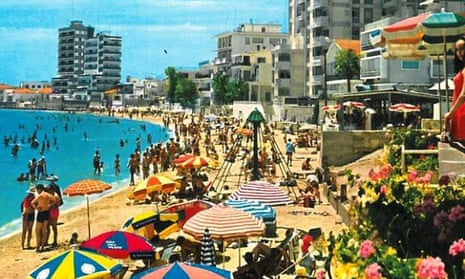
Unease in the air as Cyprus ‘ghost town’ rises from the ruins of war
Varosha, once a chic resort, is being rebuilt in the latest move of Turkey’s power play in the eastern Mediterranean
“D o you want to ride or walk?” asks Seyki Mindik. The municipal employee points under the fierce July sun towards the multicoloured bicycles stacked within view of the police barrier at the entrance to Varosha. “There is so much to see. Tourists love it here.”
Not so long ago the very notion of the eastern Mediterranean’s most famous ghost town being resurrected as a 21st-century theme park would have been unthinkable. For more than four decades there has been almost no movement among ruins of war left to rot with the passage of time.
But in Turkish-occupied northern Cyprus , transformation is in the air.
In a place whose fate could be a game-changer in the quest to put the divided island back together again, construction workers have been tidying up: laying cement, removing debris, roping off edifices sealed from public view since Ankara sent in troops and tanks in 1974.

On Demokratias street, beside buildings allowed to decay 47 years after their Greek Cypriot inhabitants were forced to flee, a mobile canteen offers cakes and juices to those who want to ogle the relics of conflict; on a section of the beach next to hotels reclaimed by nature, Turkish Cypriot authorities have erected tables, umbrellas and chairs.
All are small signs of a brewing battle over a resort that prior to becoming a bargaining chip in a game of geopolitical chess was the Mediterranean’s most glamorous destination. It was here, along the fabled sandy beach, that Richard Burton and Elizabeth Taylor played. It was here that Paul Newman enjoyed the famously turquoise waters when he spent the summer of 1960 filming the epic movie Exodus . And it was here that Europe’s cosmopolitan elite gravitated until rightwing extremists championing enosis , or union with Greece, staged an ill-fated coup with the support of the colonels then ruling Athens, prompting Turkey to invade.
Until Ankara stunned diplomats last year announcing Varosha would be partially reopened , the once vibrant enclave in the city of Famagusta – home to about 40,000 Greeks in its heyday – had lain out of reach behind barbed wire, a symbol of division but also of hope for its former residents optimistic that, at least, it had not been reoccupied like other parts of territory seized in 1974.
It is into this scene that Turkish president Recep Tayyip Erdoğan will fly when he marks the anniversary of the incursion on Tuesday. In a move that has brought condemnation from the EU, the strongman has endorsed the proposal of Ersin Tatar, – his hardline Turkish Cypriot counterpart, elected with Ankara’s support in October – for a two-state solution to the Cyprus problem.
On Friday, following morning prayers, he promised “good news” for the breakaway republic, hinting at potentially groundbreaking statements when he addresses Nicosia’s self-styled Turkish Cypriot parliament during the visit.
Since the rump republic unilaterally proclaimed independence in 1983, it has been recognised only by Turkey , fostering years of international isolation for a population not only whittled down by policies of resettlement but increasingly dependent on Ankara for aid.
This month Brussels reiterated that any solution upending efforts to reunite the two ethnic communities in a bizonal, bicommunal federation – long the focus of UN-backed reunification talks – was a non-starter.
“I want to repeat that we will never, ever accept a two-state solution,” said European Commission president Ursula von der Leyen insisting the 27-member bloc would be watching Erdoğan’s visit closely. “We are firm on that, and very united.”
For many the changes in Varosha reflect Turkish Cypriot frustration with decades of failed talks. In 2004, when Cyprus came closest yet to securing a peace deal under the then UN stewardship of the late Kofi Annan, the minority community voted overwhelmingly in favour of the plan. Greek Cypriots, by contrast, rejected it. Efforts earlier this year to find common ground to kickstart negotiations made little headway.
But Varosha’s creeping commercialisation is also viewed as part of a broader policy by Erdoğan to improve Ankara’s leverage at a time when potentially explosive tensions over rival claims to offshore energy rights in the eastern Mediterranean remain far from resolved.
“It’s part of a wider Turkish strategy, pursued in recent years, to create facts on the ground that improve their bargaining position, or become permanent gains,” says Hubert Faustmann, a professor of history and politics at the University of Nicosia in the internationally recognised south. “And it’s clearly being done to appease nationalists in Turkey and in a very offensive way for Nicos Anastasiades’s government.”

Few places are as redolent of the pain suffered by Greek Cypriots – turned into refugees overnight as heavily armed Turkish forces advanced across the Mesaoria plain towards the eastern port town. Tales of homes abandoned in mid-afternoon, meals left on tables, valuables hastily hidden by inhabitants fleeing with little more than the clothes on their back, are legendary. “What to say?” said Alexandra Orfanou, returning to Varosha to see the city and retrieve a photo, taken on the day of her engagement to her husband, Sotiris, that a kindly Turkish Cypriot doctor had found and wanted to return. “Loss, loss, loss, that’s what I feel,” she says, eyeing edifices frozen in time. “We lived in a village nearby but came here every day. I can remember taking my daughter to elementary school as if it were yesterday.”
Anna Marangou, whose family spent every summer in the town, was among those who fled in little more than flip-flops, a swimsuit and T-shirt on 14 August 1974 when Ankara launched the second phase of its “peace operation” in a land grab that saw Turkish troops occupy 37% of the island.
At 70, she can still vividly recall sipping Pimm’s on the porch of the beachfront villa from which she and her relatives took flight. “We made our way to the British bases. Everyone said we’d be back in hours,” the prominent archaeologist and art historian says.
In November when Erdoğan declared his intention to enjoy a picnic on Famagusta’s once fenced-off shoreline as part of the new policy to exploit Varosha, she responded with a cri-de-coeur video that soon went viral reminding him it was neither his homeland, nor that of Turkish investors or settlers, but belonged to Greek Cypriots who had historically inhabited it.
“Stay away from Cyprus, from Greek Cypriots and Turkish Cypriots and respect our human rights,” she says in the voiceover. “Our right to bring peace and love back again to our country, respecting each other, accepting our similarities and our differences. We can work together as long as you keep away from our land.”
But it also galls Marangou, an ardent supporter of reconciliation who co-founded the Famagusta for Cyprus movement which recently contested parliamentary elections, that successive Greek Cypriot administrations have handled negotiations with an “all or nothing” approach.
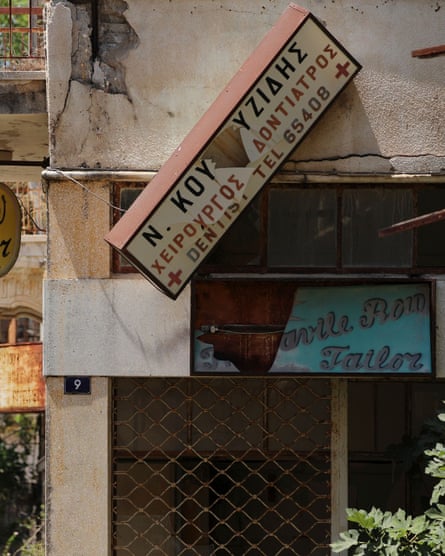
“Famagusta was always a special case,” she insists, adding that an agreement ending the territorial dispute could have played a decisive role in reaching a settlement. “It was under Turkish military occupation and never belonged to the breakaway Turkish Republic of Northern Cyprus. There was a UN resolution [stipulating] it be handed back to its lawful owners. We’ve been offered it seven times, including in 1978 when we could have swept the floors and moved back into our homes. But there was always this ‘all or nothing’ approach.”
The Anastasiades government has been chastised, at home and abroad, for its lacklustre handling of peace talks. In 2017 the Greek Cypriot leader reportedly walked out of negotiations when the moderate Turkish Cypriot Mustafa Akıncı was prepared to make unprecedented concessions.
Yet the prospect of a two-state solution also faces stiff resistance from Turkish Cypriots themselves, many appalled that a ghost town that was never theirs should now be opened to sightseers. “This place doesn’t belong to us,” says Peril Emiroğluları, taking in the dilapidated buildings still decorated with Greek signage. “The original owners should be back. We should be living in Cyprus together.”
Erdoğan has also intimated he will appeal to Greek Cypriots to return to their homes.
More than 300 have already applied to the immovable properties commission in northern Cyprus to win back real estate that is likely to cost Turkey billions in compensation. If local remedies fail they will resort to the European Court of Human Rights.
“Greek Cypriots have been deprived of their right to enjoy their properties and I am encouraging everyone to make claims in opposition to government policy,” says Achilleas Demetriades, the island’s leading human rights lawyer who also spent much of his childhood in Famagusta. “I want vindication on this issue but also reconciliation.”
A possible contender in the next presidential elections, the 60-year-old remains optimistic despite all the signs pointing to deeper partition.
Cyprus, he says, is too small to be divided and there is a “dividend to peace”.
“It is in both communities’ interest to solve the Cyprus problem. We may be in a frozen conflict but we are still in conflict. Varosha is the beacon that will guide the way. If we lose it, we lose our direction towards a solution.”
- The Observer
- Recep Tayyip Erdoğan
Most viewed

Visit Varosha Cyprus
What to know before visiting varosha, how to get there from larnaca, exploring the city of famagusta, 1. the walled city, 2. st. nicholas cathedral, varosha beach: an abandoned paradise, frequently asked questions, 1. is it safe to visit varosha, 2. what is the best time to visit varosha.
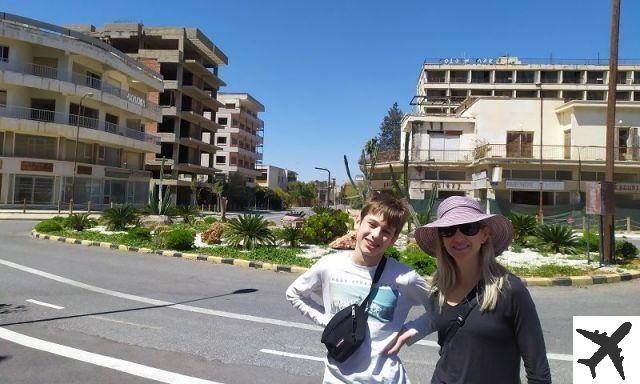
Welcome to ForTravelLovers, your world travel guide. On this occasion, we will enter the mysterious city of Varosha, located in Northern Cyprus. Known as the ghost town, Varosha is a unique tourist destination that attracts thousands of visitors every year. In this article, we will provide you with all the information you need to know before visiting Varosha, how to get there from Larnaca and the tourist attractions that you cannot miss in the city of Famagusta and on Varosha beach. Get ready for an unforgettable experience!
Before venturing out to explore Varosha, it's important to keep a few key things in mind. First of all, you should know that Varosha was a thriving tourist town in the 1970s, but was abandoned after the Turkish invasion of 1974. Since then, the area has been under military control and access has been restricted. However, in recent years efforts have been made to allow controlled tourist visits.
It is essential to respect the rules established by local authorities when visiting Varosha. Access is not allowed to certain restricted areas and it is important to follow the instructions of the tour guides. In addition, it is recommended to wear comfortable clothing and shoes, as well as sun protection, since the city is located in a coastal area with a Mediterranean climate.
If you are in Larnaca and want to visit Varosha, you have several transportation options. The most convenient way is to take a taxi from Larnaca airport to Famagusta, the closest city to Varosha. The journey takes approximately an hour and a half, depending on traffic.
Another option is to rent a car in Larnaca and drive to Famagusta. This alternative gives you greater flexibility and allows you to explore other places of interest in the region. However, you should keep in mind that you will need a special permit to enter Varosha, which you can obtain through authorized travel agencies.
Before entering Varosha, we recommend visiting the city of Famagusta, located a few kilometers away. Famagusta is known for its rich history and impressive architectural heritage. Some of the places you can't miss are:
The walled city of Famagusta is one of the main tourist attractions in the region. Its imposing walls date back to the XNUMXth century and offer a panoramic view of the city. Inside, you will find cobblestone streets, historic churches and charming squares.
The Cathedral of Saint Nicholas is another emblematic place in Famagusta. Built in the XNUMXth century, this Gothic church houses beautiful frescoes and sculptures. Although it is currently in ruins, its beauty and history make it a mandatory stop for architecture lovers.
Finally, we reached the highlight of our trip: Varosha Beach. This beach, once one of the most popular tourist destinations in the Mediterranean, is now abandoned and overgrown with vegetation. However, its natural beauty is still impressive.
Although access to the entire beach is not allowed, there are guided tours that allow you to enjoy the panoramic views and learn about the history of Varosha. During the tour, you will be able to see abandoned hotels and restaurants, as well as old tourist facilities that were once full of life.
Yes, it is safe to visit Varosha as long as you follow the instructions of the tour guides and respect the established rules. Please remember that some areas are restricted and unauthorized access is not permitted.
The best time to visit Varosha is during the spring and autumn months, when the weather is milder and more pleasant. During the summer, temperatures can be very high, so it is recommended to bring sun protection and water.
Varosha, the ghost town of Northern Cyprus, is a fascinating tourist destination that you cannot miss. Although abandoned and shrouded in mystery, Varosha remains a place full of history and natural beauty. From the city of Famagusta to Varosha beach, every corner of this place will transport you to another era. Remember to follow the instructions of the tour guides and enjoy this unique experience. You will not regret!
Until next time,
The ForTravelLovers team
Related Items
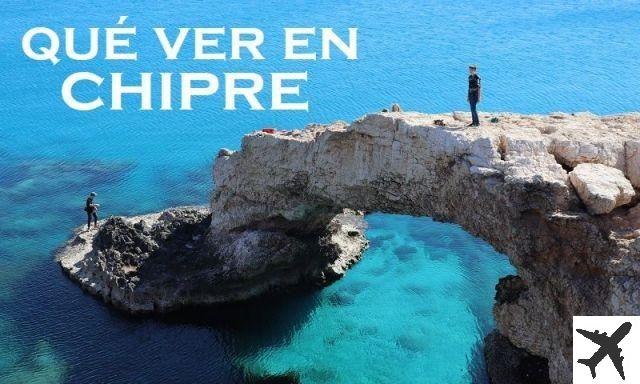
What to see in Cyprus
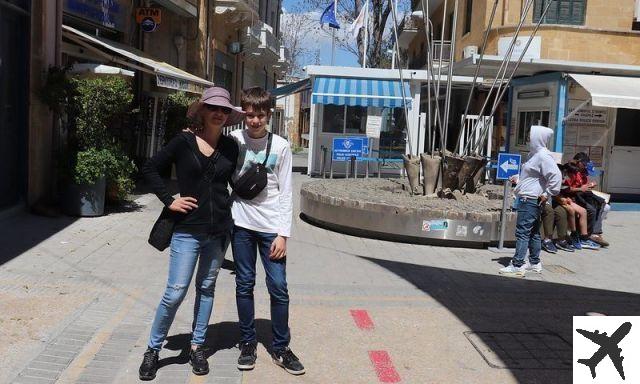
How to travel to northern Cyprus
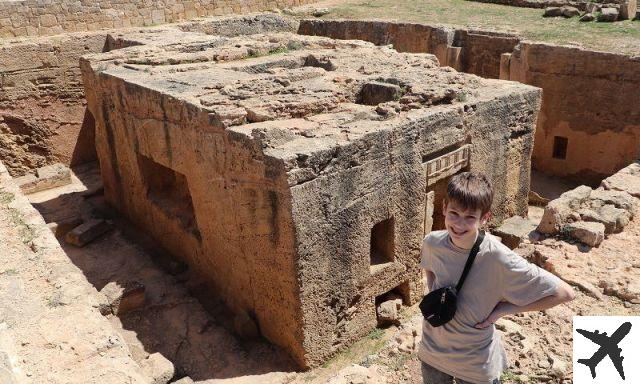
What to see in Paphos Cyprus
Add a comment of visit varosha cyprus, content for you.
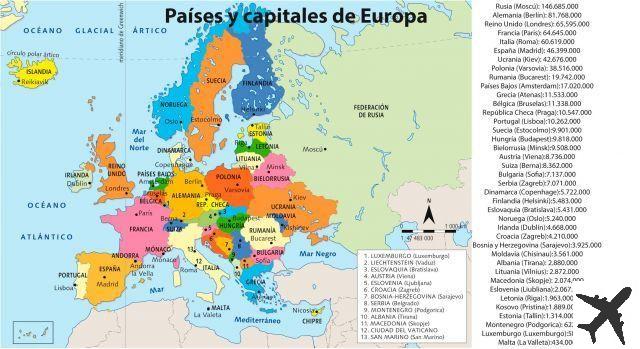
My Cyprus Life
On the insland that's more than a destination. It's a forever love!
How to get to Varosha on your own. Practical guide
The first thing to remember when thinking about how to get to Varosha is that there is no public transport between the south and the occupied side.
There are tours you can buy, you can cross the border and use public transport on the Busy side, or you can rent a car and go through customs, but it’s your responsibility here if anything should happen.
On your own to Famagusta
To pass from Ayia Napa/Protaras area, you can use the customs at Derineya. There are also daily tours, but if you want to go on your own, you have bus 501 (Ayia Napa – Paralimni – Derineya) which will take you closest to your destination. (Does not go through Protaras!)
After you’ve cleared customs, ask the Turkish customs officer to call you a taxi and he or she will. Otherwise, you have to walk 7.3 km to your destination. From what I read on the Facebook groups, the ride is not very expensive, somewhere under 10 euros.
I asked a taxi driver in the city how much he wanted to get to customs, and he said 15 euros. Now, I’m sure the amount can be negotiated.
Nicosia – Famagusta
If you are coming from Nicosia to Famagusta, then go through the pedestrian customs at Ledra Street, go to Gîrne Gate station on the busy side, and take a bus or minibus that will take you to your destination in about an hour. The final station is right next to the fortress wall of Famagusta, near the Victory Monument from the roundabout.
Buses run every 30 minutes – an hour, depending on how quickly they fill up with passengers. The price of a ticket is 65 Turkish liras (about 3 euros) and the last bus leaves from Famagusta to Nicosia at 19.00.
The recommendation would be to get your return ticket even when you arrive at your destination because usually, the last bus is full. At least that’s what the person at the counter told me when I asked.
You can check more information about the buses here
From the bus station, it is a maximum of 10 minutes walk to the entrance to Varosha, the ghost town.
🚩 See here how much time you need to visit and what you will find – Varosha, the ghost town from Cyprus
Exchange money
If you want to change euros into pounds, there are two exchange offices below the statue on the right side of the street.
There is also an exchange office in the old city.
Otherwise, you can pay by card just about everywhere.
How to get to Varosha by car
Representatives of car rental companies on the island will tell you that you cannot cross the border. But they can’t stop you.
If you decide to go there in a rented car, you will pay an extra 25 euros at the crossing point, the insurance for one month. There is no insurance for a day or a week.
You must be aware that if something happens, you will pay for everything out of your own pocket, they say.
The traffic in the busy part is more chaotic than in the south, and you also drive on the left side in the North. If you go on their roads in the highway system, watch out for fixed-speed cameras.
As far as I know, if you were fined, you will be made to pay the fine at Turkish customs. They have the system interconnected.
To cross the border between the two sides, you need a passport or identity card. The visa will not be applied to the travel documents.
🚩 You have here car rental companies recommended by tourists – Rent a car in Cyprus. Tourists recommendations!
Car rental in Katehomena
You can also rent a car in TNRC. I don’t know the prices or which company is recommended.
What I know is that you can only go through customs through Nicosia. At least that’s what the agent at the Derineya border crossing explained to me. He said that after you have passed through the capital and made the insurance for the southern part, you can then go through customs at any border point you want.
I hope I understood correctly…
Share this:
- Click to share on Facebook (Opens in new window)
- Click to share on WhatsApp (Opens in new window)
- Click to share on Twitter (Opens in new window)
- Click to email a link to a friend (Opens in new window)
- Click to share on Pinterest (Opens in new window)
- Click to share on Reddit (Opens in new window)
Hi! I am going next week to Cyprus and I really wanna go to Varosha. Is it easier to visit from Ayia Napa or Nicosia? I will stay in both places but I am not sure from where I will go to Varosha. I prefer to go without tour to have as much time as I want, I am travelling solo so the more I could reduce the costs the better 🙂
Hi. I think it will be easier if you go from Nicosia. Just take the bus from the occupied part of the city (65 lira-app 3 euros) and in one hour you are in Famagusta, the city. Walking distance to all you want to see.
Be sure you buy your ticket to go back to Nicosia when you arrive, so you are sure you have a seat in the minibus, especially if you want to go back with the last one, at 7 o’clock in the evening. This is what they said to me…
I believe that for someone that doesn’t know the area, it is more complicated to go with the busses in Ayia Napa-Paralimni and cross the border in Deryneia.
Leave a Reply Cancel reply
Your email address will not be published. Required fields are marked *
This site uses cookies.
- Famagusta Tourism
- Famagusta Hotels
- Bed and Breakfast Famagusta
- Famagusta Holiday Rentals
- Flights to Famagusta
- Famagusta Restaurants
- Famagusta Attractions
- Famagusta Travel Forum
- Famagusta Photos
- Famagusta Map
- All Famagusta Hotels
- Famagusta Hotel Deals
- Last Minute Hotels in Famagusta
- Things to Do
- Restaurants
- Holiday Rentals
- Travel Stories
- Add a Place
- Travel Forum
- Travellers' Choice
- Help Centre
How easy is it to visit Varosha? - Famagusta Forum
- Europe
- Cyprus
- Famagusta District
- Famagusta
How easy is it to visit Varosha?
- United Kingdom Forums
- United States Forums
- Europe Forums
- Canada Forums
- Asia Forums
- Central America Forums
- Africa Forums
- Caribbean Forums
- Mexico Forums
- South Pacific Forums
- South America Forums
- Middle East Forums
- Honeymoons and Romance
- Business Travel
- Train Travel
- Traveling With Disabilities
- Tripadvisor Support
- Solo Travel
- Bargain Travel
- Timeshares / Holiday Rentals
- Famagusta District forums
- Famagusta forum

Is it easy for a UK citizen to visit Varosha in a hire car ? Will I need certain documentation? Any fees to get through to Northern Cyprus? Entrance fee for Varosha itself?
How long would you advise to spend around Varosha?

Who told you Varosha is open to vistors

Varosha is not open to visitors and still has a barbed wire fence patrolled by armed Turkish guards surrounding the entire village.
You don't say where you will be in Cyprus except to say that you will be in Nicosia for a few nights.
Is this Southern Nicosia or Northern Nicosia ?
You may walk over the border in Nicosia and hire a car in the North. If you do that you can drive to the Famagusta area and can get close to the fence surrounding Varosha but that's it.
If you are staying elsewhere in Southern Cyprus such as a coastal town (Protaras, Ayia Napa, Larnaca, Limassol ) then there are companies that run day trips to Famagusta and all you need in that event is your passport and the ability to comply with Covid regulations to cross the border to the North.
Difficult to be more specific without knowing where you will be for the rest of the trip

We were staying in Northern Cyprus in September 21. We drove to Famagusta and went to see Varosha. No fee to get in just walked through a turnstile. They have a bus tour you can take or you can hire cycles to go around. We chose to walk and quite a bit of it is open to look around. We found it very interesting.
Yes Varosha has been opened to visitors. I do still remember it from before the Turkish invasion of 1974.
We visited the ghost town Varosha by ourselves. We took a taxi to the border crossing called Deryneia from Agia Napa for 20EUR then walked over the border. Passport and vaccine pass needed. After the border there is a tourist info, the guy helped us to call a taxi. We went with the taxi to the entrance of Varosha which is located near a soccer field called Dr.Fazil Kucuk. It was 15EUR. We paid with Euros. At the entrance you just walk trough a turnstile with one guard present. No entrance fee.
Super helpful information Jesper. I am going to do the same trip but from Famagusta to Agia Napa next month and I was wondering what it was like crossing at Deryneia. Good to know it's relatively straightforward!

Red Bus are doing a Varosha tour this year
Going next week from south Cyprus for a day visit will we be able to drive through ?
You will also have to pay for insurance at the border which only covers you for 3rd party so if you breakdown or have an accident it will be your responsibility for any costs to recover and pay for any damages
- Crossing into Northern Cyprus with Turkish surname 03 April 2024
- North Cyprus - Sea-Side Wedding Venues 27 December 2023
- Pasha Port Carpets, Famagusta 07 December 2023
- Can you walk down John F Kennedy Avenue? 27 September 2023
- Actual prices - Northern Cyprus 02 April 2023
- Taxi 31 January 2023
- Tours from Nicosia 11 January 2023
- Golf Course or Driving range near famagusta 27 November 2022
- Getting to famagusta and varosha 12 November 2022
- How easy is it to visit Varosha? 07 September 2022
- Hire Car going to deserted towns of Famagusta and Varosha 20 August 2022
- Taxi from Strovilia border crossing to Salamis ruins 29 July 2022
- Cycle from Ayia Napa to Famagusta 21 July 2022
- Getting to Varosha 26 June 2022
- ferry from cyprus to egypt 5 replies
- Karpas Peninsula fm Paphos (itinerary + drive times help!) 15 replies
- Palm Beach Hotel Famagusta 16 replies
- Can you go into Famagusta where it was abandoned in 1974 13 replies
- Farmagusta -what to see,what to do ,where to stay ? 8 replies
- How long does it take from Protaras to Famagusta in a car. 2 replies
- Getting around Cyprus 8 replies
- Currency 2 replies
- First time v isitor - where is best resort to stay? 2 replies
- First-time in Karpas peninsula 2 replies
Famagusta Hotels and Places to Stay
- Famagusta Tourism
- Famagusta Hotels
- Famagusta Bed and Breakfast
- Famagusta Vacation Rentals
- Flights to Famagusta
- Famagusta Restaurants
- Things to Do in Famagusta
- Famagusta Travel Forum
- Famagusta Photos
- Famagusta Map
- All Famagusta Hotels
- Famagusta Hotel Deals
- Last Minute Hotels in Famagusta
- Things to Do
- Restaurants
- Vacation Rentals
- Travel Stories
- Rental Cars
- Add a Place
- Travel Forum
- Travelers' Choice
- Help Center
How easy is it to visit Varosha? - Famagusta Forum
- Europe
- Cyprus
- Famagusta District
- Famagusta
How easy is it to visit Varosha?
- United States Forums
- Europe Forums
- Canada Forums
- Asia Forums
- Central America Forums
- Africa Forums
- Caribbean Forums
- Mexico Forums
- South Pacific Forums
- South America Forums
- Middle East Forums
- Honeymoons and Romance
- Business Travel
- Train Travel
- Traveling With Disabilities
- Tripadvisor Support
- Solo Travel
- Bargain Travel
- Timeshares / Vacation Rentals
- Famagusta District forums
- Famagusta forum

Is it easy for a UK citizen to visit Varosha in a hire car ? Will I need certain documentation? Any fees to get through to Northern Cyprus? Entrance fee for Varosha itself?
How long would you advise to spend around Varosha?

Who told you Varosha is open to vistors

Varosha is not open to visitors and still has a barbed wire fence patrolled by armed Turkish guards surrounding the entire village.
You don't say where you will be in Cyprus except to say that you will be in Nicosia for a few nights.
Is this Southern Nicosia or Northern Nicosia ?
You may walk over the border in Nicosia and hire a car in the North. If you do that you can drive to the Famagusta area and can get close to the fence surrounding Varosha but that's it.
If you are staying elsewhere in Southern Cyprus such as a coastal town (Protaras, Ayia Napa, Larnaca, Limassol ) then there are companies that run day trips to Famagusta and all you need in that event is your passport and the ability to comply with Covid regulations to cross the border to the North.
Difficult to be more specific without knowing where you will be for the rest of the trip

We were staying in Northern Cyprus in September 21. We drove to Famagusta and went to see Varosha. No fee to get in just walked through a turnstile. They have a bus tour you can take or you can hire cycles to go around. We chose to walk and quite a bit of it is open to look around. We found it very interesting.
Yes Varosha has been opened to visitors. I do still remember it from before the Turkish invasion of 1974.
We visited the ghost town Varosha by ourselves. We took a taxi to the border crossing called Deryneia from Agia Napa for 20EUR then walked over the border. Passport and vaccine pass needed. After the border there is a tourist info, the guy helped us to call a taxi. We went with the taxi to the entrance of Varosha which is located near a soccer field called Dr.Fazil Kucuk. It was 15EUR. We paid with Euros. At the entrance you just walk trough a turnstile with one guard present. No entrance fee.
Super helpful information Jesper. I am going to do the same trip but from Famagusta to Agia Napa next month and I was wondering what it was like crossing at Deryneia. Good to know it's relatively straightforward!

Red Bus are doing a Varosha tour this year
Going next week from south Cyprus for a day visit will we be able to drive through ?
You will also have to pay for insurance at the border which only covers you for 3rd party so if you breakdown or have an accident it will be your responsibility for any costs to recover and pay for any damages
- Crossing into Northern Cyprus with Turkish surname Apr 03, 2024
- North Cyprus - Sea-Side Wedding Venues Dec 27, 2023
- Pasha Port Carpets, Famagusta Dec 07, 2023
- Can you walk down John F Kennedy Avenue? Sep 27, 2023
- Actual prices - Northern Cyprus Apr 02, 2023
- Taxi Jan 31, 2023
- Tours from Nicosia Jan 11, 2023
- Golf Course or Driving range near famagusta Nov 27, 2022
- Getting to famagusta and varosha Nov 12, 2022
- How easy is it to visit Varosha? Sep 07, 2022
- Hire Car going to deserted towns of Famagusta and Varosha Aug 20, 2022
- Taxi from Strovilia border crossing to Salamis ruins Jul 29, 2022
- Cycle from Ayia Napa to Famagusta Jul 21, 2022
- Getting to Varosha Jun 26, 2022
- From Ayia Napa to Famagusta 5 replies
- First-time in Karpas peninsula 2 replies
- First time v isitor - where is best resort to stay? 2 replies
- Wireless Broadband Internet 7 replies
- Getting around Cyprus 8 replies
- Currency 2 replies
- Larnaca or Ercan for Famagusta 3 replies
- Palm Beach Hotel Famagusta 16 replies
- Famagusta 7 replies
- Karpas Peninsula fm Paphos (itinerary + drive times help!) 15 replies
Famagusta Hotels and Places to Stay

Varosha: The Enigmatic Ghost Town of Cyprus
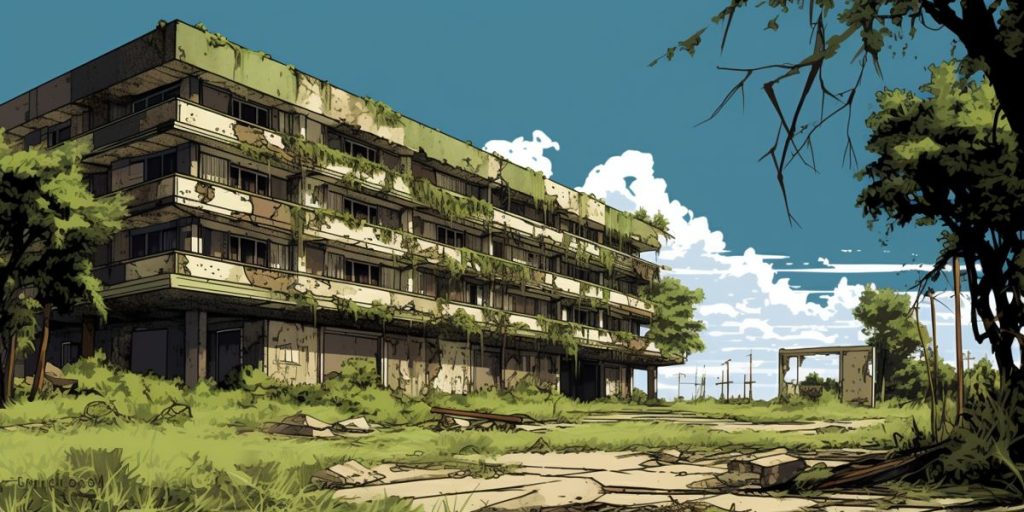
📸 Varosha: The Enigmatic Ghost Town of Cyprus
📍 Located in Cyprus, Varosha was a thriving tourist area in the 60s and 70s, with luxury hotels and celebrity visitors. But in 1974, it was abandoned when Turkey took control, turning it into a haunting ghost town. Nature has now taken over, adding to its eerie allure. The future of Varosha is uncertain, but its haunting beauty continues to captivate visitors. #Varosha #GhostTown #Cyprus #History
What is the history and current state of Varosha in Cyprus?
Varosha, located in Cyprus, was a popular tourist area in the 60s and 70s, known for luxury hotels and celebrity visitors. However, in 1974, it was abruptly abandoned when Turkey took control of the city and has since become a ghost town. Today, nature is reclaiming the abandoned district, and it’s a peculiar attraction for tourists. The future of Varosha remains uncertain, with ongoing debates about its revival. Despite its past and uncertain future, its haunting beauty continues to captivate visitors.
Located on the outskirts of Famagusta, Varosha, Cyprus’s very own ghost town, continues to intrigue and bewitch, even four decades after it was deserted and sealed off. The district’s eerie stillness and haunting beauty leave no one indifferent, creating a sense of melancholic fascination.
The Golden Era: A Paradise for Tourists
In the 60s and 70s, Varosha was a celebrated tourist heaven that drew sun-starved visitors from across the globe. The district was known for its opulent hotels, lovely beach promenades, and delectable eateries. It boasted a glamorous clientele, including luminaries such as Elizabeth Taylor, Richard Burton, and Raquel Welch. These high-profile visits added to the district’s allure, making it a bustling center of luxury and enjoyment.
The Sudden Desertion: A City Stands Still
In 1974, as Turkey took control of the city, Varosha was abruptly abandoned by its inhabitants. The district was subsequently cordoned off, creating a chilling tableau of frozen-in-time hotels and residences. The blockade, which still stands, drew a sharp line under the district’s thriving past, converting it into an uninhabited shell.
The Present Day: A Ghost Town in Limbo
Today, Varosha is a peculiar attraction for foreign tourists, who flock here to glimpse the abandoned district from the barriers. Right alongside the forsaken hotels lies the bustling Palm Beach, a stark contrast to the ghost town with its white sand and turquoise water. Hundreds of locals and tourists visit this popular spot every day. Interestingly, a visitor’s review on Trip Advisor mentions the poignant sight of the deserted buildings along the shore, while also highlighting the uniqueness of the location, making it worthy of a visit.
Nature’s Reclamation: Life Amid Decay
The silent streets and vacant buildings of Varosha have been slowly reclaimed by nature, adding an ethereal charm to the district. Bursting through cracked concrete and overtaking deserted balconies, wildflowers have found a home in the midst of decay, painting a hauntingly beautiful picture of life persisting amid abandonment.
The Future: A Question Mark
Varosha, once a buzzing tourist hotspot, now stands as a testament to a turbulent past. The ongoing debates regarding the district’s future often find conflicting viewpoints. However, one thing remains clear – a common desire for the area to be revived and given a new lease of life. The vision of returning Varosha to its former glory is a dream held by many, but as of now, the district’s future remains uncertain.
Despite its past and uncertain future, Varosha, with its ghostly beauty and contrasting vibrancy, continues to captivate the hearts of those who visit. It stands as a stark reminder of the past, a strange attraction in the present, and a symbol of hope for the future.
Lessons Learned
The story of Varosha teaches us several important lessons.
Firstly, it highlights the fragility of political stability and the devastating impact it can have on communities. The sudden abandonment of Varosha in 1974 serves as a stark reminder of how conflict and power struggles can upend the lives of innocent people and leave behind a ghost town. It is a lesson in the importance of diplomacy, peacekeeping efforts, and finding peaceful resolutions to conflicts to prevent such devastating consequences.
Secondly, Varosha is a reminder of the impermanence of human creations and the power of nature to reclaim what was once built. The abandoned district, now overrun with wildflowers and slowly decaying, shows that no matter how grand or prosperous a place may be, it can be reduced to ruins over time. It serves as a lesson in the transient nature of human achievements and the need to cherish and protect the environments we create.
Lastly, the uncertain future of Varosha highlights the complexities of revitalization and the competing interests and perspectives involved. The debates surrounding the district’s future demonstrate the challenges of finding a balance between preserving history and heritage and meeting the needs and desires of present-day communities. It underscores the importance of thoughtful and inclusive decision-making processes when it comes to revitalizing and repurposing abandoned areas.
Overall, the story of Varosha teaches us about the fragility of human lives and creations, the power of nature, and the complexities of revitalization. It serves as a somber reminder of the consequences of conflict and the need for peaceful resolutions, as well as the importance of preserving history and heritage while adapting to changing times.
About The Author
Demis Papadopoulos
Leave a comment cancel reply.
Your email address will not be published. Required fields are marked *
Save my name, email, and website in this browser for the next time I comment.

Recreating Famagusta’s past for the future
Festival aims to ‘revisit all the atrocities that happened, understand them, forgive them and throw them away’.
“It was a ghost town to me until I met a Varoshian. I never called it a ghost town again after that, because it’s not a ghost town; we made it into a ghost town. It’s the Varoshians that made me understand that it’s not a ghost town; that it’s a town that people lived in and have memories in,” said Aysu Arsoy as she described her ‘Cabinet of Lost Memories’ project set in the Bandabuliya in the heart of the walled city of Famagusta.
Imprints of last weekend’s New Famagusta Museum Festival (FNM) linger in my mind as I attempt to process the stories, images, oral histories and moments in time as I weaved myself through the festival’s programme.
The core of the festival pertinently took place in the heart of the walled city of Famagusta and within the newly renovated premises of the city’s old municipal market (Bandabuliya).
Geared towards the cultural revival and social reconciliation of Cyprus, an array of events unfolded in the market in the morning, followed by satellite events in the old city and Varosha.
Everything I delved into during the one-day festival poignantly awoke in me a new understanding of the area, its peoples, both past and present.
It’s through Aysu Arsoy and Hacer Basarir that I discovered the ‘Delik Plajı’ (The Hole Beach), a popular spot savoured by those living in the walled city until it was repurposed to expand Famagusta port. The audience shared their memories of the café set on the beach; their recollection of the juke box in the café that played ‘Oh Carol’ by Neil Sedaka, their group photographs in beachwear posing as carefree youth just outside the fortified walls of the city which were opened up in three locations (hence the name The Hole) for people to have access to the sea.
Arsoy and her ‘Cabinet of Lost Memories’ is one who made me understand how connecting the past to the future and sharing our memories can indeed reconcile traumas of war. It’s once she realised that the objects that she was collecting from a field in the vicinity of the old town was actually the dumping ground field of Varosha that she began creating meaning to the hundreds of toys, broken ceramics, plates, marbles and the likes.
“The more pieces I collected and shared, the more Varoshians I met and I began to learn about which house they lived in, which flowers they collect, which food they taste… I couldn’t see Varosha from my own eyes anymore, I started seeing it from their eyes, the ghost town suddenly changed perspective for me,” she said.
Indeed, that was the beauty of this festival: changing perspectives, building new narratives, witnessing the past and in turn looking towards the future.
“Art can evolve,” said Nurtane Karagil who was echoed by Eralp Kortach, both project leaders of the FNM. “You can actually shape your ideas and space through the arts and it’s one of the big helpers in our life in Cyprus; it enables us to ask so many good questions which are usually traumatic and don’t have answers to but art always helps you understand your environment and your space,” she added, pinpointing that the artists and researchers participating in the festival are known for their work on the Cyprus issue. “Not in a sad, traumatic way, but always embracing the past while generating the future.”
To this end, the Famagusta New Museum (FNM) is an initiative which was instigated by former deputy culture minister Yiannis Toumazis almost a decade ago and had to be adjusted according to the times, such as the opening of Varosha to the wider public.
“The idea was to revisit all the atrocities and nasty things that happened to our people, understand them, forgive them and throw them away; lock them in closed spaces for no one to see them anymore and focus on the future and how we would use the physical space of our city, how we would bring together all the communities that live here, how we could make things thrive again together in peace and in harmony,” he said.
With the motto, ‘I understand and forgive the past, I love and generate the future’ the Pierides Foundation, of which Toumazis was director at the time, and the K10 community space led by Karagil drove the idea forward. Today, it’s a bold contribution towards the island’s reconciliation materialised through collating and exposing an abundance of audio-visual data from Varosha and the area that enables the social, cultural and political reactivation of the occupied town, while readdressing the traditional role of museums in contemporary societies through three axes.
The main axis is its online museum to be launched in the coming months, which consists of a repository of a lost and found platform where people who lived in and have memories from Famagusta share their own photographs and materials with the wider public. In parallel, a number of physical events and hands-on-workshops on tradition and its revival that lean towards the experiential aspect of reconciliation have been taking place, including last weekend’s closing festival.
Perhaps the most valuable axis of the museum is its walking tours (sounds maps) in both Varosha and old Famagusta that invite people to walk through Famagusta through the voices and memories of past and current residents. The geolocated audio tours are activated once on location where you can hear the voices and narratives of the community and thus foster a deeper understanding of Famagusta’s rich heritage.
“These are emotional walks in Varosha,” said Karagil. “A lot of people found a reason to enter Varosha through these sound maps because the way in which Varosha was opened wasn’t democratic and as locals, we found it difficult to enter that space (under these circumstances). Using sound maps in these kinds of locations makes you much freer because the sound gives you another layer of the space. It’s not about where you are allowed to go and see, you can have another layer of reality that you can connect with. It’s really important for us to hear real stories about our past and remember it in a beautiful way.”
There are five sound maps currently available both in Varosha and the old city of Famagusta, with more set to be recorded in the near future.
The first walk, recorded by Toumazis who lived in Varosha until he was 14, recollects his childhood memories, he walks you past his elementary and high school, his friends’ and relatives houses, he talks about the architecture of the time, his favourite toy shop which is now abandoned and looted and the first theatrical play he went to. And he also talks about difficult memories, the first time he saw a dead body, what he packed as they left the town under the sound of war planes.
Avghi Frangopoulou, also a teenager when she left Varosha, delivers a sentimental walk of Varosha. She sets the tone by establishing that she’s not a ghost and that her city is not a ghost either.
Serdar Atai offers a walk from his childhood home and walks you around the old town of Famagusta through his rich knowledge of the heritage of the town.
Inal Bilsel, who also delivered a live performance at the closing of the festival, lends an alternative approach with his sound map.
“I called my sound map Hijacked Memory because I grew up in a house that originally belonged to a Greek Cypriot who apparently didn’t have the chance to live there… when the apartment was given to us as a university lodging, and as I was growing up, I contemplated about all these issues and I felt like I was living someone else’s memories and I was hijacking that memory from whoever was supposed to live there.”
His sound map ends at this apartment house and takes you to different points on the outskirts of Varosha, including the zoo and his childhood playground that is now abandoned.
Salamis Aysegul Sentug takes you on a walk from a fictional point of view based on her yet to be published debut novel set in 1886. Her protagonist is a Victorian traveller who travelled to Cyprus on her honeymoon and develops a friendship with Cypriot woman with whom she travels the island. It’s through this character that Salamis shares memories of Famagusta.
These are merely highlights of the festival and the initiative as a whole. The guided tours of the exhibition, panel series, the workshops on imaginative and hopeful future editions of Famagusta Orange Festival, screenings, and musical programme all contributed to my walking away with faith in a multitude of individuals who are striving to bring the past of Famagusta to the foreground, all the while aspiring to manifest a future that seeks to heal the region’s hefty history and build on new memories. I’ve definitely got new ones to cherish.

IMAGES
VIDEO
COMMENTS
HOW TO GET TO VAROSHA. Varosha is 4 km from the centre of Famagusta in the Turkish Republic of Northern Cyprus (TRNC). Most travellers arrive in Cyprus and cross into TRNC using one of the many checkpoints described below. We flew into Larnaca, took a bus to Nicosia and crossed the border on foot into Lefkosa.
Most visitors to Varosha (Maras) will have their own views on this legacy of the 1974 Turkish Invasion/ Liberation of Northern Cyprus but Tripadvisor is not the place to share them. Whatever your views, I would unreservedly recommend visiting this place if only for a glimpse into the past - but don't expect a time capsule.
After Turkey took control of northern Cyprus in the 1970s, the resort town Varosha was left empty. Residents and tourists planned to return, but the resort was fenced off and remained so for decades.
Once a thriving resort and seaside town, the ghost town of Varosha has sat abandoned since the 1970s. While you're not allowed to enter the fenced-off areas, you can still have a stroll or bike ride around the area to explore the deserted buildings and rubble—a time capsule of what was once the most glamorous spot in Cyprus.
Published on August 26, 2020. On the east coast of the Mediterranean island nation of Cyprus is a ghost town trapped in time. There's a car dealership filled with cars from 1974 and shops with ...
On July 20th, 1974 the glamorous lifestyle of Varosha was brought to a screeching halt by the Turkish invasion of Cyprus. As the Turkish and Greek Cypriot armies advanced to meet in combat on Famagusta streets, the citizens of Varosha fled, leaving their possessions behind, fearing a massacre. For the last 40 years, the city has remained vacant ...
Famagusta beach. I crossed the border into Northern Cyprus in October 2022, and I visited Salamis, Famagusta and Varosha. This guide will help you to understand all of the requirements of the Famagusta border crossing and the ghost town of Varosha. This article has been updated to keep it relevant for 2024, but the photographs are all from 2022.
Apr 2023. The island of Cyprus is home to many charming and beautiful towns and villages, but there is one that stands out for its eerie and mysterious past - the ghost town of Varosha. Located in the city of Famagusta, this once-thriving resort destination was abandoned in 1974 and has remained untouched for nearly half a century.
A visit to the Turkish occupied section of Cyprus may be questionable; however, as a historian I felt it would provide me with better context about the events of 1974. ... We were only there to see Varosha, with the entire visit probably taking us about 2 & 1/2 hours. You could certainly extend your trip and explore the port of Famagusta ...
Turkish president Recep Tayyip Erdoğan, centre, and president of Turkish occupied northern Cyprus Ersin Tatar, right, visit Varosha in November 2020. Photograph: EPA.
A view of deserted buildings of the tourist area of Varosha, in the fenced off area of Famagusta, in the Turkish-occupied north of the divided eastern Mediterranean island of Cyprus, on October 6 ...
Varosha has been deserted since the 1970s. Northern Cyprus says it will soon reopen the derelict district of Varosha, a once popular tourist resort that has remained a ghost town since the Turkish ...
Discover Varosha Beach Resort in Famagusta, Cyprus: A 1970s resort city now stands abandoned, caught in the middle of a divided island. Trips. ... Visit Adventures. Trips Highlight.
Once a thriving resort and seaside town, the ghost town of Varosha has sat abandoned since the 1970s. While you're not allowed to enter the fenced-off areas, you can still have a stroll or bike ride around the area to explore the deserted buildings and rubble—a time capsule of what was once the most glamorous spot in Cyprus.
2. What is the best time to visit Varosha? The best time to visit Varosha is during the spring and autumn months, when the weather is milder and more pleasant. During the summer, temperatures can be very high, so it is recommended to bring sun protection and water. Conclusion. Varosha, the ghost town of Northern Cyprus, is a fascinating tourist ...
July 5, 2021. The ghost down of Varosha, Cyprus. Credit: Rena Choplarou. Illustration: Greek Reporter. Varosha is an abandoned southern quarter of the Cypriot town of Famagusta, whose inhabitants fled during the second phase of the Turkish invasion of Cyprus in 1974. The town came under Turkish occupation, and it has remained abandoned ever since.
From the bus station, it is a maximum of 10 minutes walk to the entrance to Varosha, the ghost town. 🚩 See here how much time you need to visit and what you will find - Varosha, the ghost town from Cyprus. Exchange money. If you want to change euros into pounds, there are two exchange offices below the statue on the right side of the street.
Part of Varosha is open to visitors and access is free. We walked but there is bicycle hire available. The turnstile entrance is at 35.11765 33.95469 (just enter this in Google Maps and it'll pin point it) and there's a large free car park as well. Edited: 1 year ago. Report inappropriate content.
Part of Varosha is open to visitors and access is free. We walked but there is bicycle hire available. The turnstile entrance is at 35.11765 33.95469 (just enter this in Google Maps and it'll pin point it) and there's a large free car park as well. Edited: 1 year ago. Report inappropriate content.
Discover the enigmatic ghost town of Varosha in Cyprus. Its eerie stillness and haunting beauty continue to fascinate visitors.
Varosha was Cyprus's own Riviera until conflict split the island in two in 1974 and the resort's Greek-Cypriot community fled, leaving a ghost town. But on Thursday Turkey's military took down the ...
Geared towards the cultural revival and social reconciliation of Cyprus, an array of events unfolded in the market in the morning, followed by satellite events in the old city and Varosha.